HEART HORSE AWARD WINNER
Read Arnie’s Story


HEART HORSE AWARD WINNER
Read Arnie’s Story

History in Wellington



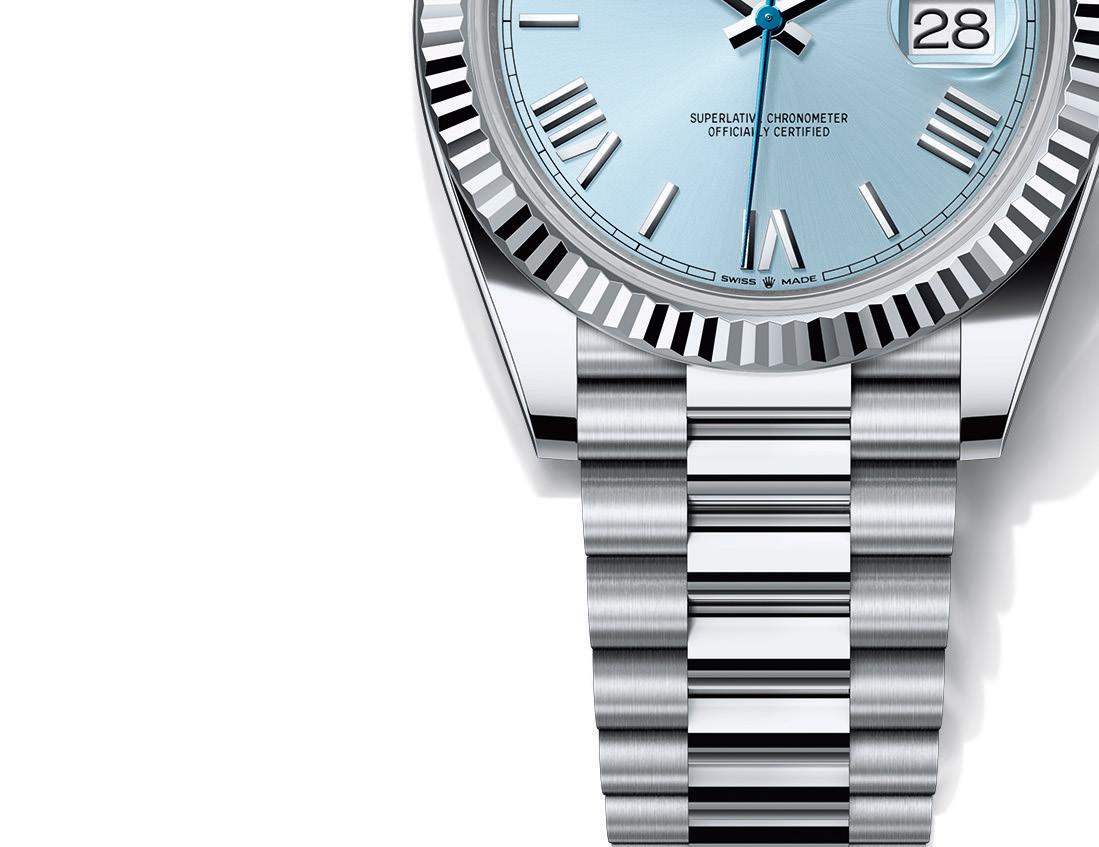






Your young equestrians deserve more than the standard horse barn. Build them a B&D equestrian facility, crafted for the champions of tomorrow.


Official Magazine of the United States Equestrian Federation
US EQUESTRIAN MAGAZINE
Volume LXXXIX, Spring 2025
PUBLISHED BY
The United States Equestrian Federation, Inc.
CHIEF MARKETING & CONTENT OFFICER
Vicki Lowell | vlowell@usef.org
EDITOR-IN-CHIEF
Debbie Elliot | delliot@usef.org
CREATIVE DIRECTOR
Candice McCown | cmccown@usef.org
ADVERTISING DIRECTOR
Kim Russell | 859 225 6938 | krussell@usef.org
DIRECTOR OF SPONSORSHIP & SALES
Layson Griffin | lgriffin@usef.org
ASSISTANT DESIGNERS
Kendall Neubeiser, Kate Strom
EDITORIAL STAFF
Kim Russell
CONTRIBUTING WRITER
Zack Ryle
Equestrian Magazine (ISSN 1548-873X) is published five times a year: Horse of the Year Special Edition, Spring, Summer, Fall, and Winter, by the United States Equestrian Federation®, 4001 Wing Commander Way, Lexington, KY 40511; Phone: (859) 258-2472; Fax: (859) 231-6662. (ISSN:1548-873X). NOTE: Effective Spring issue of 2018, Equestrian magazine will be published and provided electronically and only four editions will have printed copies and be provided by U.S. Mail. The Winter issue will only be provided electronically. The Horse of the Year issue will be mailed only to competing members as of the date of publication and the year immediately prior to the date of publication. USEF is not responsible for the opinions and statements expressed in signed articles and paid advertisements. These opinions are not necessarily the opinions of USEF and its staff. While the Federation makes every effort to avoid errors, we assume no liability to anyone for mistakes or omissions. It is the policy of the Federation to report factually and accurately in Equestrian and to encourage and to publish corrections whenever warranted. Kindly direct any comments or inquiries regarding corrections to Glenye Cain Oakford goakford@usef.org or by direct dial 859-225-6941. POSTMASTER: Send address changes to US Equestrian, 4001 Wing Commander Way, Lexington, KY 40511. Canadian Publications Agreement No. 40845627. For Canadian returns, mail to Canada Express, 7686 #21 Kimble Street Mississauga, Ontario, Canada, L5S1E9. (905) 672-8100. Reproduction of any article, in whole or part, by written permission only of the Editor. Equestrian: Publisher, United States Equestrian Federation®, Chief Executive Officer, William J. Moroney (859) 225-6912. Director of Advertising, Kim Russell (859) 225-6938. Copyright © 2024 Equestrian is the official publication of the United States Equestrian Federation, the National Governing Body for Equestrian Sport in the USA, and is an official publication of USEF.
Published at 4001 Wing Commander Way, Lexington, Ky 40511 USequestrian.org



Keep your gear safe and performing with innovative drying cabinets that revolutionize equestrian care. Preserve, protect, and perform better!
EFFICIENT DRYING
Quickly and effectively dry wet gear, including saddles, blankets, boots, and more, ensuring everything is ready for your next ride.
ENHANCED LONGEVITY
By minimizing wear and tear, drying cabinets help prolong the life of expensive equestrian gear, saving on replacement costs.
HYGIENE AND SAFETY
Thorough drying prevents mold and bacteria growth, ensuring clean and hygienic equipment for both you and your horse.
E-mail: sales.na@podab.com
Tel: +1 800-683 48 73 www.podab.com

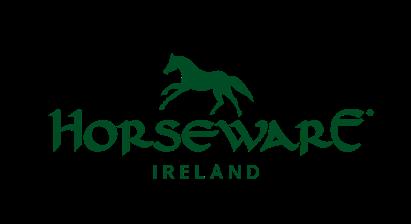

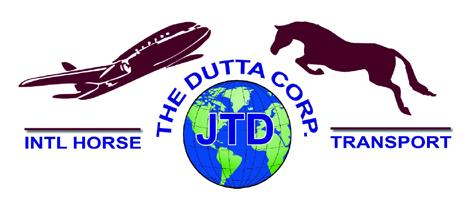




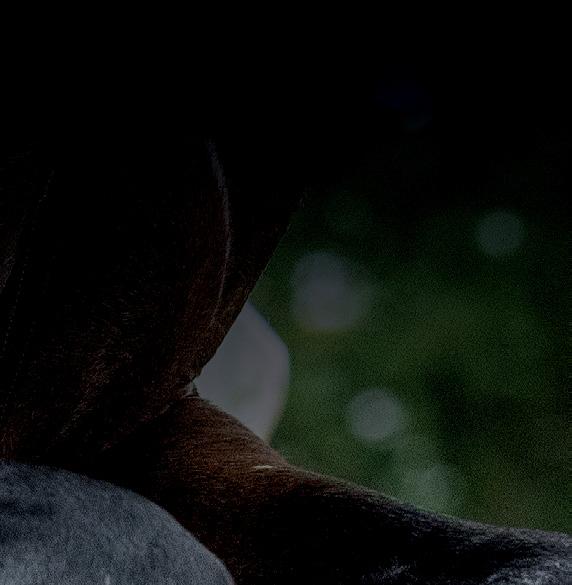
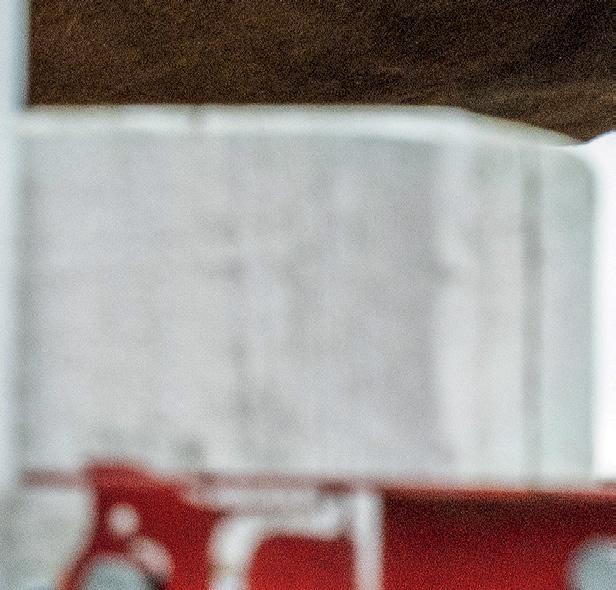

























• Technical XC boot designed for protection, shock absorption and stability


• V-cut front edge streamlines boot profile
• Lightweight, ventilated and breathable
• Tough but flexible TPU outer





• Front and rear moulded strike guards protect legs and keep boots securely in place
• Designed in conjunction with mimSAFE, the creator of mimCLIP which is used on XC courses worldwide





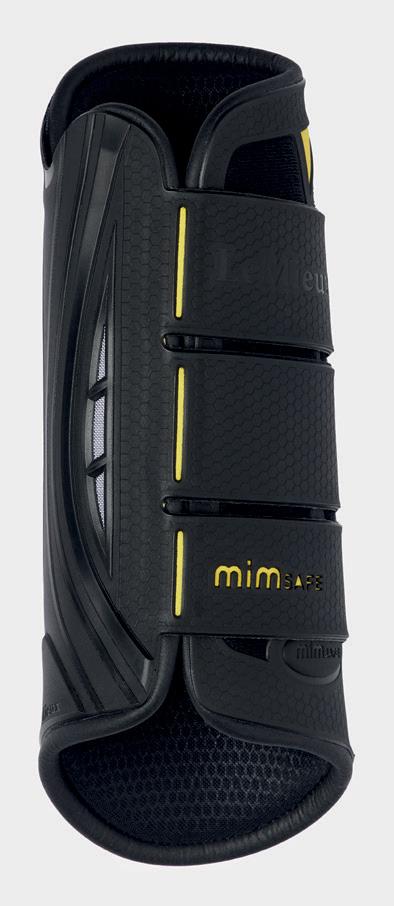



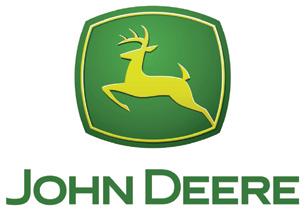









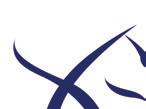



















Dear USEF Members,
Spring always brings about new hope and new opportunities for growth. In January, we held a very successful USEF Annual Meeting in Lexington, Kentucky. With the theme of “It’s All About the Horse,” our workshops and sessions were as popular as ever. During the Annual Meeting’s General Session, we were able to unveil the 2025-2028 US Equestrian Strategic Plan.
One of my favorite parts of the calendar year is celebrating the success of our members and horses during the Pegasus Awards Dinner and the SmartPak/USEF Horse of the Year Awards Dinner. New this year to the Pegasus Awards Dinner was the inaugural Heart Horse Award. This award was designed to honor the valuable work carried out by horses in our Community Outreach Program. In this edition of the magazine, we take a closer look at Arnie, the first-time winner of the Heart Horse Award, and how he has changed the lives of so many people at Great Oak Assisted Programs in Aiken, South Carolina.
On the competition front, I am extremely excited about the launch of the US Equestrian Open where, just as in other sports, we will crown a winner of the US Equestrian Open in the three Olympic disciplines of jumping, eventing and dressage. There are designated qualifier events, some of which began last fall, and will culminate in a finals for the top qualifiers. There is a great microsite (usequestrianopen.org) created so you, our members and fans, can follow the qualifying standings during the year along with great stories about the horses and riders vying for this new, highly prestigious title. The creation of a series like this has the opportunity to elevate our sport to levels we have not reached before, and to open the eyes of fans who have yet to learn about our great sport. On March 29, the US Equestrian Open Jumping Finals brought the biggest names in the sport to Wellington International. What a great competition it was, and I personally want to congratulate all those who competed. You can learn about the competition and winners in our special coverage in this issue. If you did not get the chance to watch it live, I encourage everyone to watch on the USEF Network. Also, be on the lookout for the US Equestrian Open Eventing and Dressage Finals later this year. You won’t want to miss these events!
As we celebrate Mother’s Day, we’d like to honor all the moms in our lives, both human and equine. In our feature on riding during and after pregnancy, we talked to a group of strong professional and amateur riders who shared their experiences of being both mothers and equestrians. This article also provides some veterinary advice on riding pregnant mares, and how to ensure their pregnancy is as safe and comfortable as possible.
As a parent, I know that a child’s safety is always top of mind whether it be their first time in the ring or their 1000th. I remember how nerve-wracking it was to watch my children in their first horse show, and I wish I had this issue’s Juniors’ Ring back then! The article is dedicated to getting young riders ready for their debut show and includes both style guides for junior equestrians — and survival tips for stressed out parents. Our Safe Sport section of the magazine also brings to light recent changes to our MAAPP (Minor Athlete Abuse Prevention Policies) that took effect December 1, 2024. I encourage all equestrians, but especially our parents and junior competitors, to review these important changes that are all designed to keep kids safe.
As the snow begins to melt away bringing spring’s warm (and often wet) weather to most parts of the country, it also sparks a rise in skin ailments for horses, especially those caused by insect bites. Our latest Vet’s Corner addresses all types of skin issues and allergies and offers advice on how to tackle fly problems at your barn.
I know you will enjoy this issue that delivers many informative and timely articles written by equestrians, about equestrians and for you — our US Equestrians.
In closing, I want to thank you for always being an advocate for the care and wellbeing of our equine partners. I am constantly in awe of all our equestrian community can do ... and does do. As we look ahead to the rest of the 2025 season, I wish you luck and good health in the pursuit of your equestrian goals.

Tom O’Mara President
Athlete-Loved Performance

CALLIE SCHOTT
Professional Show Jumper

US Equestrian announced the appointment of former USEF Eventing Development Coach Leslie Law to the position of Chef d’Equipe and High Performance Manager for the Defender U.S. Eventing Team, and Karyn Shuter, who will take on the newly developed role of U.S. Eventing High Performance Advisor. Both Law and Shuter will begin in their respective roles immediately.
“As riders, we are very excited with the selection of Leslie Law and Karyn Shuter as the leaders for our high-performance goals,” said Tamie Smith, USEF Eventing High Performance athlete. “After an extensive and thoughtful evaluation process, we believe their combined expertise and passion will inspire our team to achieve new heights. We extend our gratitude to USEF for their support and for allowing us to be a part of this process. We are confident this duo will lead us toward the success and excellence we’ve all been aspiring to achieve.”
Law, an Olympic team silver medalist and individual gold medalist, has served as the USEF Development Coach for more than a decade, bringing a thorough understanding of the foundations of the USEF eventing programs and pathway to his new role. His commitment to the developing pathway has contributed to numerous top results for the U.S. on international stages at FEI Eventing Nations Cup CCIO3*/4* competitions.
“Having supported the USEF eventing programs and teams for more than a decade, I have a clear understanding of our depth of talent and ability,” said Law. “I’m honored the athletes supported this transition and are confident in this new structure. With Karyn [Shuter] coming into the fold, alongside our
program staff, we are starting this new quad heading in the right direction with the same collective goals in mind.”
“I’m pleased to join the U.S. Eventing Team in the new role of High Performance Advisor,” said Shuter. “The U.S. has a longstanding and successful history in the sport of eventing and a lot of untapped potential. I’m looking forward to the future with this program and to contributing to supporting the athletes and identifying ways we can improve performance at the international and championship levels.”
Shuter brings a wealth of knowledge and experience to the position. In her role, she will directly liaison with athletes and stakeholders on performance plans, while supporting Law in developing a long-term strategy to produce sustained success.
“We are pleased with the athlete engagement during the identification and interview process for these positions,” said Bill Moroney, Chief Executive Officer of US Equestrian. “Both Leslie Law and Karyn Shuter will report to Managing Director of Eventing, Amber Braun. As they begin their work, they have our full support, and we look forward to them sharing their plans and vision with our key eventing stakeholders. Together we share the collective goal of building sustained success and a culture of excellence leading into LA 2028 Games and beyond.”
Christina Vaughn, who has worked with Law on the USEF Eventing Development programs for the past 10 years, will transition into the role of USEF Eventing Elite Program Director and Team Leader.







US Equestrian announced that 11 new organizations have become a part of the USEF Community Outreach Program. These organizations are now recognized as USEF Community Outreach Organizations and join a network of 29 prior organizations dedicated to equine-assisted services, therapy, and learning who are united by their standards and mission to offer these services on a free or sliding scale. Since the program’s inception in 2021, the program has helped thousands experience the life-changing benefits of horses.
The new 2025 USEF Community Outreach Organizations are listed below in alphabetical order:
• Brook Hill Retirement Center for Horses (Forest, Va.)
• Forward Stride (Beaverton, Ore.)
• Glenayre Equestrian Program (Lumberton, N.J.)
• Great and Small (Boyds, Md.)
• Havenwood Equestrian Center (Radford, Va.)
• Ivy Hill Therapeutic Equestrian Center (Perkasie, Pa.)
• Lovelane Special Needs Horseback Riding Program (Lincoln, Mass.)
• Rising Starr Horse Rescue (Wilton, Conn.)
• Saddle Up Scholars (Churchville, Md.)
• Speaking of Horses Incorporated (Barboursville, Va.)
• The Shane Center for Therapeutic Horsemanship (Centerburg, Ohio)
Each organization applied and was evaluated against important eligibility requirements, and subsequently, approved by the US Equestrian Community Outreach Task Force, consisting of executive staff, USEF board members, and athletes. Organizations in the Community Outreach Program receive several benefits, including eligibility to apply for a grant through the USEF Opportunity Fund. USEF is committed to supporting these organizations through competitive grant opportunities aligning with our vision to bring the joy of horse sports to as many people as possible
“The USEF Community Outreach Program, launched in 2021 as a new initiative with input from our members, is dedicated to supporting organizations across the country that provide equine-based learning opportunities and support the positive impact horses can have within their local communities,” said USEF President Tom O’Mara.“We congratulate each of these organizations on the outstanding work they are doing to bring horses and people together to change lives. I encourage the equestrian community to consider a donation to the USEF Opportunity Fund today. Every contribution counts.”
Additional information about each organization and the complete USEF Community Outreach Program directory is available at usef.org/about-us/diversity-inclusion/ organizations-program/program-directory
Applicants must complete and submit the digital application form on or before the application deadline. Please review Additional Resources prior to starting the digital application, which includes important information such as eligibility requirements, required documentation, and more.
Individuals can make a tax-deductible donation to the USEF Opportunity Fund online at usef.org/about-us/diversity-inclusion/opportunity-fund

US Equestrian is currently accepting applications for the 2025 Higher Education Equestrian Scholarships. This scholarship program awards five $1,000 scholarships annually to graduating high school seniors who are committed to advancing their equine knowledge or equestrian experience while in college.
The scholarships are available to US Equestrian competing members and subscribers who are current high school seniors and are preparing to enter college full-time in the fall of 2025. Equestrians from all US Equestrian-affiliated breeds and disciplines pursuing any major are encouraged to apply.
Applicants may meet the requirement to continue their involvement with horses during college through equine-related coursework, participation on a college riding team or club, or horse-related internships, jobs, or volunteer work.
Scholarship funds will be issued directly to the recipients’ educational institutions to be applied to their tuition costs.
The application package includes proof of full-time college enrollment, a letter explaining the applicant’s involvement in horse-related activity, a reference letter from an individual in the horse industry, and an essay written by the applicant answering questions about their current and future involvement with equestrian sports. Visit usef.org/forms/higher-education-equestrian-scholarship to access the application form and read full instructions. The deadline for applications is July 31, 2025.
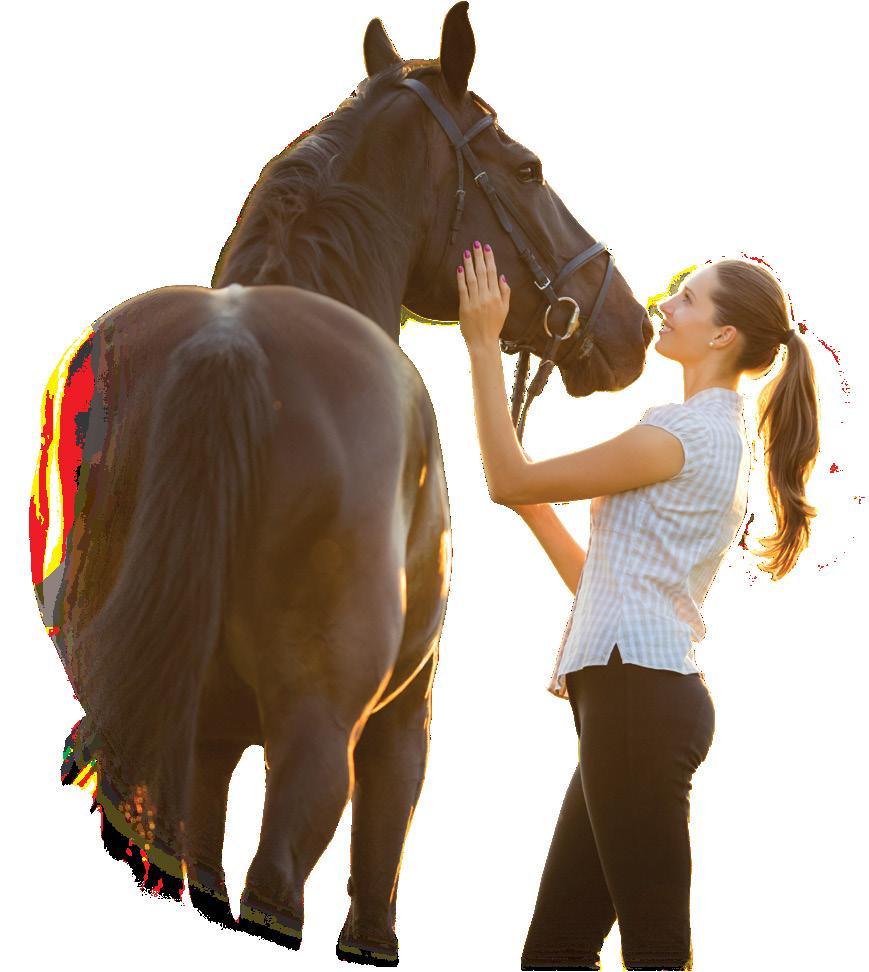
At the first sign of lameness, affordable NexHA lubricates joints and calms inflammation associated with equine osteoarthritis.1,2 An FDAapproved generic bioequivalent to Legend® (hyaluronate sodium), NexHA helps keep joint pain in check and your partnership competitive for years to come.
For more information, contact your veterinary distributor, Vetoquinol sales representative, or scan the code.
Visit us online at Vetoquinolusa.com


1
2
IMPORTANT SAFETY INFORMATION: The safety of NexHA has not been evaluated in breeding stallions or in breeding, pregnant, or lactating mares. The following adverse reactions have been reported following intravenous use of NexHA Injectable Solution: occasional depression, lethargy, and fever. NexHA is approved only for intravenous injection.
(hyaluronate sodium)
Injectable Solution 10 mg/mL For Intravenous Use In Horses Only
BRIEF SUMMARY: Before using NexHATM (hyaluronate sodium) Injectable Solution for horses, please consult the product insert, a summary of which follows.
CAUTION: Federal law restricts this drug to use by or on the order of a licensed veterinarian.
INDICATIONS: NexHATM Injectable Solution is indicated in the treatment of joint dysfunction of the carpus or fetlock in horses due to non-infectious synovitis associated with equine osteoarthritis.
DOSAGE AND ADMINISTRATION: 4 mL (40 mg) injected intravenously. Treatment may be repeated at weekly intervals for a total of three treatments. Use aseptic technique and inject slowly into the jugular vein. Horses should be given stall rest after treatment before gradually resuming normal activity.
Discard any unused portion of the drug and the empty vial after opening.
CONTRAINDICATIONS: There are no known contraindications for the use of NexHATM Injectable Solution in horses.
WARNING:Do not use in horses intended for human consumption.
HUMAN WARNINGS: Not for use in humans. Keep this and all other drugs out of reach of children.
ANIMAL SAFETY WARNING: Not for intra-articular use.
PRECAUTIONS: Radiographic evaluation should be carried out in cases of acute lameness to ensure that the joint is free from serious fracture.
The safety of NexHATM injectable Solution has not been evaluated in breeding stallions or in breeding, pregnant or lactating mares.
ADVERSE REACTIONS: No local or systemic side effects were observed in the clinical field studies using hyaluronate sodium injectable Solution.
POST-APPROVAL EXPERIENCE: While all adverse reactions are not reported, the following adverse reactions are based on voluntary post-approval reporting for hyaluronate sodium injectable Solution: Occasional depression, lethargy, and fever.
To report suspected adverse events, contact Vetoquinol USA, Inc. at 1-800-835-9496. For technical assistance or to obtain a copy of the Safety Data Sheet (SDS), contact Vetoquinol USA, Inc. at 1-800-267-5707. For additional information about adverse drug experience reporting for animal drugs, contact FDA at 1-888-FDA-VETS or online at www.fda.gov/reportanimalae.
Made in France
Manufactured for: Vetoquinol USA, Inc. 4250 N. Sylvania Ave. Ft. Worth, TX (USA) 76137 www.vetoquinolusa.com
Approved by FDA under ANADA # 200-432 439313 01/2024
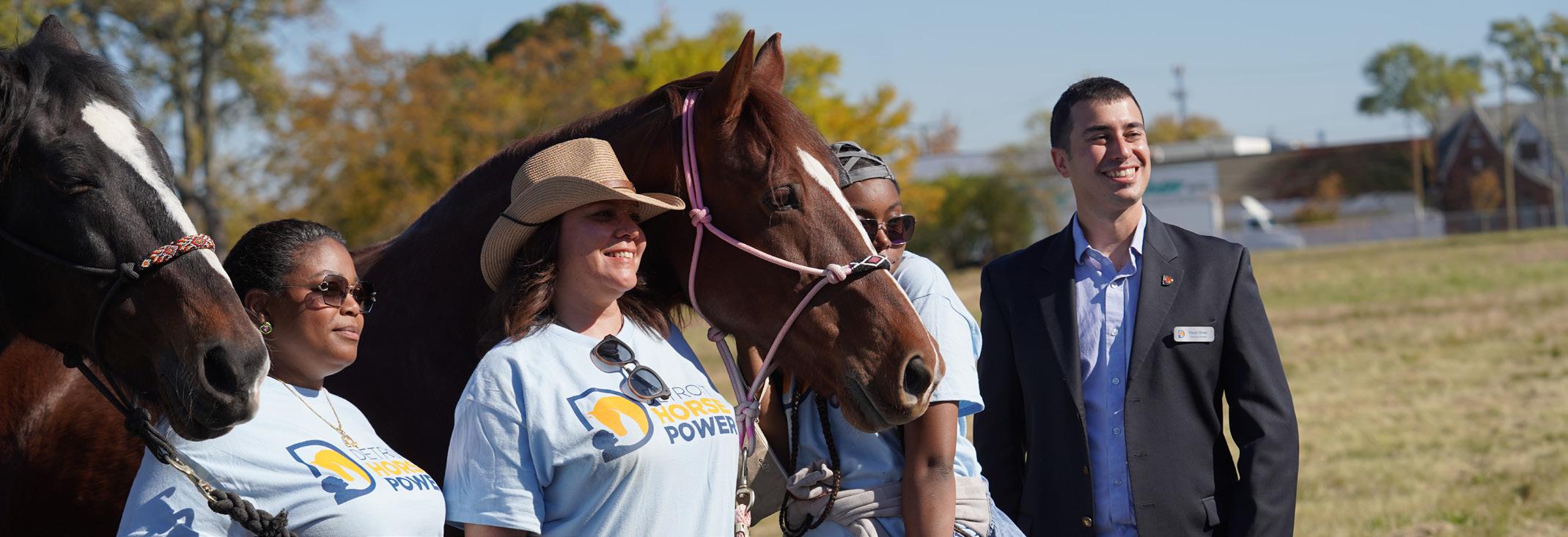
Construction began this spring on Detroit Horse Power’s new facility in the Hope Village neighborhood of Detroit, Mich., which is expected to open in spring of 2026. Once completed, it will be the largest urban equestrian center in the U.S.
“Detroit is a city that has lost a lot of people and a lot of industry,” said David Silver, the 501(c)(3) nonprofit’s Executive Director and founder, following the groundbreaking in October 2024. The city has a lot of open space where there used to be buildings, homes or other kinds of institutions that are no longer there, and revitalizing that derelict land to put it to good use has opened up new opportunities for organizations such as Detroit Horse Power.
Silver, who grew up eventing, was an elementary school teacher prior to founding Detroit Horse Power in 2015. He was very interested in social emotional learning that teaches character skills such as confidence, perseverance and empathy. “Those kinds of non-cognitive abilities really make a huge impact on students being able to thrive and find success later in life,” he explained. When he thought about his own personal experiences developing such important skills, Silver kept returning to the life lessons he had learned from horses. “In hindsight, it is crystal clear that horses helped to shape the person I am today — and conversely, that kids like my students in Detroit would never have the deep and life changing opportunities that I knew horses could provide.”
Detroit Horse Power currently transports students from urban areas to barns across southeast Michigan to teach them life skills through riding and caring for horses. Once the new center is completed, however, all activities will take place in a centralized location on a 14-acre lot. The $12 million, 26,395-square-foot facility will include seven acres of paddocks, a stabling aisle with 17 stalls, an indoor arena, outdoor arena, round pen, and a 1/2-mile bridle path along the perimeter of the property. There will also be classrooms, offices and a community space where they will facilitate youth development programs.
The summer camp program is anticipated to grow from 100 students to over 500 annually, while the after-school program will increase from 40 students to 100 year-round at the new facility. “We’ll have access to horses any day of the week, so it’s not just the number of students that will grow, but the depth of programming they can access,” Silver explained.
In addition, “For the first time, we’re going to be able to offer field trips, which came about through a partnership with the Detroit Public School system. We expect several thousand students every year to come through the barn doors and get introduced to horses and the life lessons that the horses can teach them. I think we will open the doors for so many students to think differently about their future when they have had access to the incredible opportunities that horses provide.”
Detroit Horse Power is one of the organizations within US Equestrian’s Community Outreach Program, they have also been the recipient of two grants from the USEF Opportunity Fund, with each grant being utilized toward the building of their new facility.


The Arabian Horse Association (AHA), the International Andalusian and Lusitano Horse Association (IALHA) and Scripps Miramar Saddlebreds were among the breeds and disciplines that took part in the 136th Rose Parade on January 1, 2025. The parade route spanned 5.5. miles, with around 700,000 spectators filling the streets and bleachers.
“The Tournament of Roses parade is considered the Grand Daddy of parades. It is an incredible opportunity for our riders, horses and breeds to be showcased at an international level,” said Nancy Harvey, Marshal for the Versatile Arabian Parade group.
“Personally, it has been an honor for me to represent the Arabian and other breeds off and on for over 30 years,” Harvey said. “We love to showcase the joy and love we have for our horses both at the parade and in the more intimate environment of Equestfest. Thank you to our riders, their horses, our walkers, sponsors, and especially our PIT crew. We couldn’t do it without all of you.”
The Rose Parade, also known as the Tournament of Roses Parade, takes place annually on New Year’s Day, but the equestrian participants had the opportunity to take part in a special preview called Equestfest on December 29, 2024, at the Los Angeles Equestrian Center. Each unit got to show off their skills in a two-hour family-friendly event that included roping, drill teams, trick riders, and cavalry displays before they took part in the parade itself.
Following the devastation from the Los Angeles wildfires, US Equestrian awarded two grants totaling $100,000 through the USEF Equine Disaster Relief Fund to support the efforts aiding the equine population impacted by the fires.
Fleet of Angels was awarded a $60,000 grant to further support their work in helping the equestrian community across the Los Angeles area. This grant went specifically to providing feed, critical supplies, and vet care funding assistance for displaced horses, such as the hundreds that they aided at the Los Angeles Equestrian Center.
“We are beyond grateful to be the recipient of one of US Equestrian’s Equine Disaster Relief grants,” Fleet of Angels Founder and Executive Director Elaine Nash stated. “We have worked with US Equestrian in previous natural disasters and their financial assistance has been invaluable in moments of need.”
The Foundation for Pierce College Wildfire Response was awarded a $40,000 grant. At the peak of the wildfires, 245 horses resided at their facility in Woodland Hills, Calif. As an evacuation site that is maintained year-round to provide shelter for horses in times of need, the Pierce College Equestrian Center
has been of service to the surrounding equestrian community for several decades.
“Thank you from all of us at the Equestrian Center at Los Angeles Pierce College. It is an honor and a privilege for us to serve the equestrian community in times of peril,” said Marcie Sakadijan, Farm Manager at Pierce College.
Developed in 2005 during the aftermath of Hurricanes Katrina and Rita, the USEF Equine Disaster Relief Fund helps ensure horses’ safety and well-being. Since its inception, the fund has now distributed more than $800,000 to help with disaster recovery and preparedness for horses including but not limited to hurricanes, tornadoes, floods, blizzards, and fires.
“The devastation left behind by the wildfires in Los Angeles is unfathomable. But whenever there are tragedies like these, there are also countless people who are doing great work to help their communities. Fleet of Angels and the Pierce College Equestrian Center are doing incredible work in helping horses displaced by these fires,” US Equestrian CEO Bill Moroney stated. “I also want to add my sincere thanks to everyone who has given to our Equine Disaster Relief Fund, which makes grants like these possible.”

“T his series is huge for U.S. riders. From here, I’m going to step back, give my horse some time to rest and plan for the rest of the year. [The US Equestrian Open Final] is a huge goal of mine for this year.”
- Dressage rider Devon Kane on the US Equestrian Open of Dressage and her goal of making it to the Final in Thermal, Calif.

Natalie Dean shares a magical moment with a young fan at the FEI Jumping Nations Cup Wellington CSIO4* in Wellington, Fla.
Phillip Odden, a member of the 2025 USEF Developing Athlete and Equine Program for Combined Driving, with Odden’s Illdar and Odden’s Tellinor at the January Developing Athlete Clinic.

Anna Buffini and Fiontini were victorious in the Grand Prix Freestyle at the 2025 Del Mar Dressage Affaire CDI3* in Calif.
Below: Members of the American Saddlebred Horse and Breeders Association (ASHBA) visit Melissa Moore’s Sunrise Stables as part of the 2025 ASHBA Youth Conference.


“S he shows up to work every day. She likes her job, she likes doing things well, and she goes along with my motto: If you’re going to do something, do it well. That’s what makes her so special — she finds enjoyment in working hard.”
- Sharon White talking about her mount, Jaguars Duende, on the US Equestrian Open Podcast.
by Debbie Elliot

Environmental allergens and insect bites can all cause itching and infection when spring brings warm, wet weather.
Springtime can cause a whole host of equine skin issues, no matter what area of the country you live in. As temperatures rise and humidity increases, so do itching, inflammation and skin irritation. One of the main causes is insect bite allergies, also known as Insect Bite Hypersensitivity (IBH).
Common culprits of IBH are Culicoides spp, or “no-see-ums,” which are small biting midges that thrive in warm humid conditions. Stable flies and house flies are also implicated in IBH. While they look very much alike, only stable flies draw blood. House flies do not penetrate the epidermis, instead they feed on secretions around the mouth, nostrils, eyes, genitalia and any abrasions or wounds. These flies may carry Habronema or Draschia that can cause summer sores.
“The other fly that commonly affects horses, particularly if they’re kept in groups, is the horn fly,” said Dr. Susan L. White DVM, MS, diplomate ACVIM. “They reproduce in cattle manure but can spread to horses, especially if they are in close proximity to cows.” Horses that are kept on straw bedding might also be susceptible to tiny straw mites. “Sometimes if the horse has gone from normal behavior and having nice skin to frenetically scratching itself, it might be because of these mites,” Dr. White said.
According to Dr. White, the degree of the allergic response to any kind of fly bite is
dependent on two factors: one, the number of insects biting the horse, and two, the horse’s individual immune response to the proteins in the insect’s saliva that are triggering the allergy.
The key to reducing IBH is to create an environment that is unsuitable for insect propagation, Dr. White said. It is not enough to simply manage manure, as stable flies and house flies breed in rotting vegetation as well as manure. Culicoides breed in any moist, wet or marshy areas. If you live in a rainy and muddy area, chances are you will not be able to completely control insects, she warned, but you can drastically reduce them. Manure sanitation and the drainage of any marshy, wet muddy areas as well as removing rotting vegetation helps reduce fly populations. Timing your horse’s turnout can also help reduce exposure. Different types of flies have different feeding schedules: house flies and stable flies are most active during warm sunny hours, whereas Culicoides spp like dusk and dawn. By determining the most prevalent insect in your area, “you can time your horse’s turnout to protect them from exposure,” Dr. White said.
While turned out, there are a variety of fly sheets and masks horses can wear to protect them from fly bites. “Fly leggings or boots are good protection against flies that land on the lower legs,” Dr. White said. The mesh boots
Time turnouts to avoid flies’ feeding schedules, such as dusk and dawn.

To find a veterinarian near you who offers PulseVet® shock wave therapy, visit Zomedica.com/PulseVet
To learn more, call or click Zomedica.com • 800.245.4417 info@zomedica.com

•90% success in treating back pain and kissing spines
•Helps speed the healing of tendon and ligament injuries
•81% improvement in horses with Navicular Syndrome
•Clinically proven to reduce lameness associated with chronic orthopedic conditions


attach with Velcro and create a barrier so that flies cannot land on the horses’ legs to bite or lay eggs (Bot flies). For horses that are very sensitive to flies, a full body suit offers head-to-tail protection. These suits often also protect against UV radiation and sunburn.
If your horse is mostly in a stall, installing a stall fan to create a wind current can limit the flies’ ability to land. “However, you need to know where the insects are landing on your horse so you can direct fan wind towards the affected part,” Dr. White said. Make sure that the fan is specifically made for barn use as indoor box fans can be a fire hazard in a dusty barn environment.
Dr. Susan White
There are many different brands of fly repellent, some made with permethrin (a synthetic pyrethroid) and others with pyrethrin (a natural insecticide). Whichever type you choose, read the ingredient list to see how much of the active ingredient is present in the bottle. Dr. White recommends looking for those that are made up of at least 2 percent of active ingredients. Be aware that some horses will envelop an allergy to the fly repellent, further aggravating skin irritation and lesions.
Feed-through fly control products contain an insect growth regulator (IGR) and are added to the horse’s diet. The active ingredient is passed through the horse’s system into the manure. The IGR prevents fly eggs from maturing into adult flies.
Dr. White also recommends fly parasite insects, which are tiny, non-stinging wasps that target fly larvae in the environment. The wasps feed on the fly larvae, therefore preventing them from maturing. “The wasp larvae are sent monthly by companies that provide them and are spread in all areas flies may breed,” Dr. White explained.
Cold hosing can ease some of the symptoms of fly bites as it soothes the skin, reduces inflammation and eases pain temporarily. Soothing non-medicated shampoos, such as those made with oatmeal, can also help. Solar radiation increases the sensation of itch, so try not to stand your horse in the sun to dry, Dr. White said. When possible, keep your horse in the shade. If your horse has been aggressively scratching, there may be areas of abraded skin and or sores that can become infected, in which case, you should talk to your veterinarian about topical medications or shampoos.
There are many supplements on the market that claim to treat skin issues, however, you should consult your veterinarian before administering any of them to your horse. In addition, if you plan to use an antihistamine, steroid or topical medication, do so under the supervision of your veterinarian and read the USEF Drugs and Medication pamphlet to ensure that it does not violate the Clean Sport program. If in doubt, call the USEF Drugs and Medications department at 800-633-2472 and speak to an expert.
Pastern dermatitis (also known as scratches or mud fever) is a skin condition that affects the horse’s lower legs, especially the palmar region of the pastern and fetlock area. It is common in the springtime in regions that have rain, mud and wet vegetation. “If the skin is wet for a long period of time, it becomes macerated, and the keratin coat is not intact,” Dr. White explained. “That allows allergens, bacteria and/or fungi to penetrate the skin and cause secondary infections. Pastern dermatitis can also cause swelling, scabbing, hair loss, and lameness.”
Aside from avoiding having your horse stand in muddy or wet ground for long periods of time, “the first rule of thumb when dealing with pastern dermatitis is to gently clean the affected area with a mild shampoo,” said Dr. White, who recommends using 2 percent chlorhexidine shampoos while avoiding Betadine as it dries the skin. Dry the legs after washing with a dedicated “horse towel,” then “keep the legs clean, such as with polo wraps or gentle bandages to protect the skin from further irritation while they heal,” she added. Barrier creams can also be used, but again, talk with your veterinarian and check that the product does not contain ingredients that violate the USEF Equine Drugs and Medications rules if you are competing.





Delicately detailed with sculpted butter ies
• Bridle shines with metallic accents
• Mane and tail boast braided detailing





Shown approximate size of 5" tall

Renowned artist Nene Thomas beautifully weaves her passion for the harmonious balance of nature, horses, and butter ies in this enchanting gurine—the rst of its kind. In the debut issue, “Graceful Beauty,” behold a magni cent white horse standing tall amid a urry of vibrant blue morpho butter ies. This gurine embodies the virtues of strength and gracefulness, reminding us that true power is found in stillness and gentleness.
From your rst glimpse, you’re sure to admire this majestic beauty’s gilded bridle with its jewelry-like appearance and details that combine the quiet strength of the horse with the eeting joy of butter ies, a perfect reminder to enjoy every beautiful moment in life.
YES! Please send the Enchanting Wonders collection by Nene Thomas for my review as described in this announcement. I need send no money now. I will be billed with shipment. I am under no obligation. I understand that I can return my item free of charge SEND NO MONEY NOW!


Send no money now to claim your FREE Preview.
Send no money now. “Graceful Beauty” can be yours for the issue price of $39.99 (plus $9.99 total for shipping and service, and sales tax; see HamiltonCollection.com); billed with shipment.
This gurine debuts the Enchanting Wonders collection by Nene Thomas. Collect as many as you like, or cancel at any time by notifying us. Our 365-Day Guarantee assures your satisfaction. Claim your FREE PREVIEW today!
Scan Code to Shop










Above: House flies feed on secretions around the mouth, nostrils, eyes, genitalia, and any abrasions or wounds.
Right: Fly masks and Velcro fly boots can protect horses from bites.
Dermatophilosis is a bacterial infection of the skin commonly called rain rot. It occurs in wet or humid conditions and causes crusty scabs, matted hair and, if severe, open wounds. Dermatophilosis can affect the legs, back, underbelly, shoulders and rump, but is especially problematic when under the saddle. “The bacteria live in the superficial layers of the skin,” Dr. White explained, and can be prevalent in horses that are shedding, sweating or have dirty hair. “In an early diagnosis, the treatment is to remove the scabs with a curry comb and bathe with a mild shampoo,” she said. In more severe cases, use a medicated shampoo or antibacterial ointment. Dermatophilosis can be spread by tack and brushes, therefore grooming equipment, saddle pads and tack used on a horse that has it should not be shared and should be disinfected regularly.
People usually only worry about adult ticks, but their larvae also need blood to develop and can attach themselves to horses. “The larval forms of ticks tend to be small and grey, so they are particularly hard to spot on dark-skinned horses,” Dr. White warned. If you live in a tick-infested area then you should keep weeds and grass mowed to six inches in height or less, she advised. Ticks climb up grasses and brush and onto the horse’s legs, head and tail, then spread to other parts of the body. Ticks
can transmit diseases, such as Lyme Disease, which causes swelling, lameness, and neurological symptoms. Check tick-prone spots such as the ears, face mane and neck, tail and dock, under the belly, legs, and groin area by running your hands over your horse’s body or using a flashlight in areas of dense hair. Single adult ticks may cause a nodule as large as a golf ball and can be pruritic and cause itching. If the tick has already left the lesion a small central ulcer will be present.
Eosinophilic granulomas, also known as nodular necrobiosis of collagen or collagenolytic granulomas, are hard, non-itchy skin lumps found on the back, often under the saddle. They are caused by an overactive immune response, often linked to insect bites, trauma, or other allergens. “If you catch them early, they can be treated with systemic corticosteroids,” said Dr. White, but “if they’re there for a long period of time, they will eventually calcify and are hard to remove.” The best way to prevent eosinophilic granulomas is by fly management and insect control, as detailed above.
With any spring allergies, whether they are caused by insect bites or the environment, the first line of defense is regular, careful grooming. “Your horse gets a skin exam every time you do a good job grooming, and it gives you the opportunity to catch ailments early,” Dr. White said.
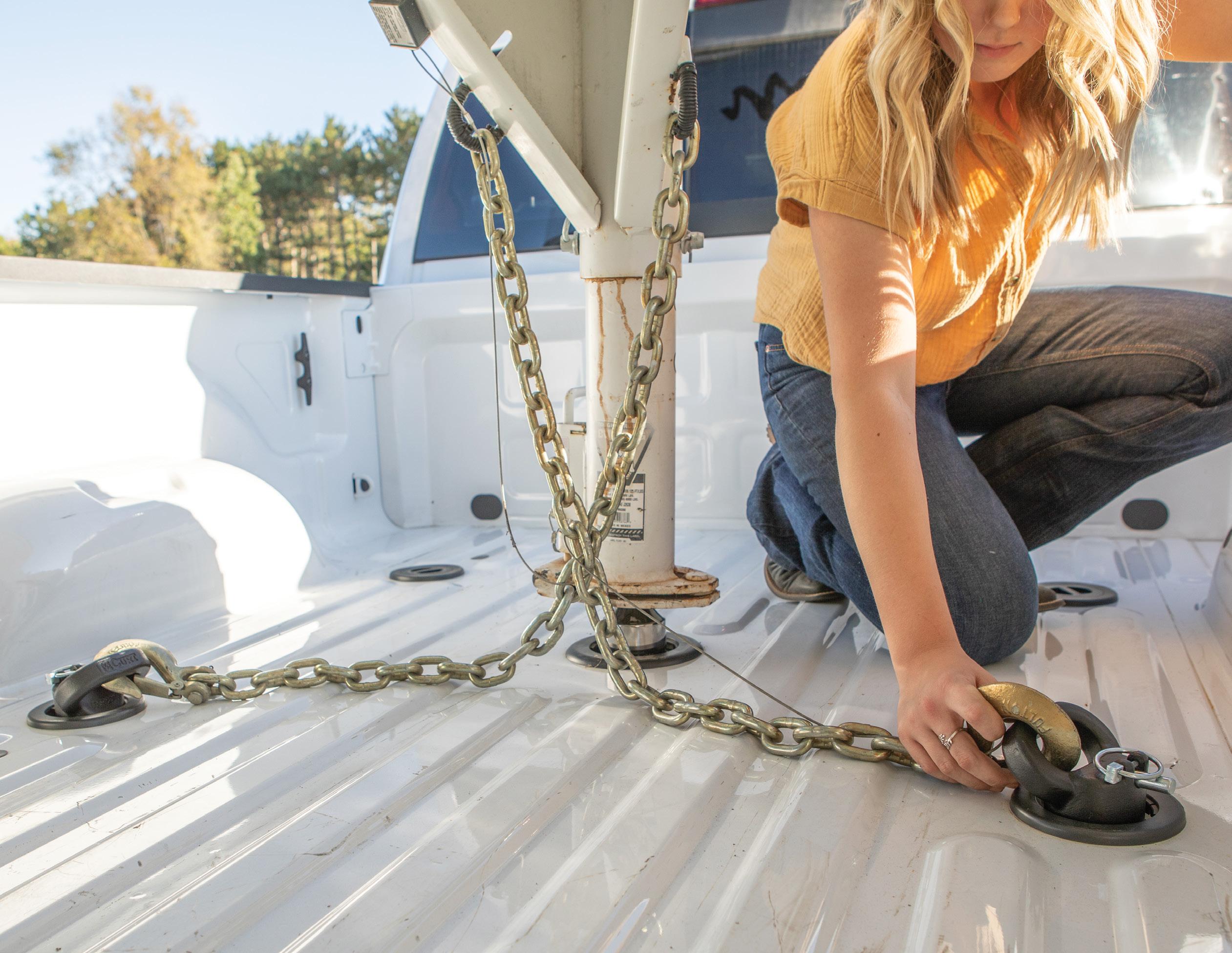
For trucks with a puck system, an OEM puck system gooseneck kit is the easiest way to tow a gooseneck trailer. The components can be installed or removed quickly, as necessary.
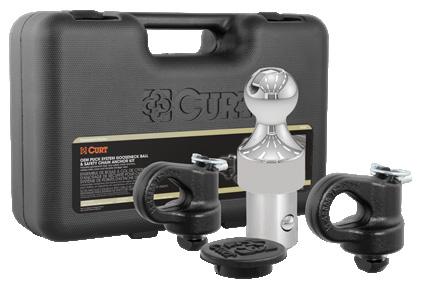

CURT OEM-style gooseneck hitches are a unique variant of the traditional method, featuring an all-in-one, custom-fit design that bolts to the truck frame like a factory hitch. No additional brackets required.


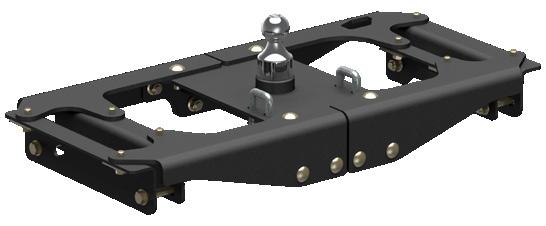
For trucks with 5th wheel rails already installed, CURT offers 5th wheel rail gooseneck hitches. These 5th-wheel-to-gooseneck adapters easily drop into any industry-standard base rails.
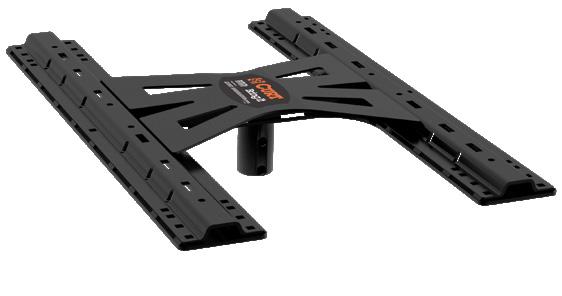

by Debbie Elliot

Preparing a young rider for their show ring debut can be (almost) stressfree with careful planning and strategic shopping.
You never forget your first horse show! This life-altering event is a rite of passage for all equestrians if they have aspirations of competing, whatever the level. While the most important thing is always to make sure you and your horse have fun and stay safe, choosing the right outfit and following the dress codes for each class or discipline are essential parts of the first horse show experience.
Joyce Brinsfield, owner of Ballyhigh Show Stable at Brinsfield Farm, LLC. in Versailles, Ky., has guided many young riders, and their parents, through their debut show. Brinsfield, who has also coached the University of Kentucky Equestrian Team, said the first item of discussion in show planning is always the cost, “because that usually causes a lot of issues for people.” Once parents have realistic financial expectations, they can review what type of show is the best fit, such as a schooling show or rated show, as that will determine what type of show clothes they need, she said.
Before they start shopping for show clothes, Brinsfield gives parents a list of what is correct for the ring, often with photos and prices. “I’ll have some clothes on hand that other kids have outgrown,” she added. In addition, Brinsfield either goes with the family to buy boots to ensure they fit correctly, or she makes sure she knows the person at the tack shop who advises them. “I’ve had kids come back with boots that were too tall, too short, or not the right
Young riders should remember that the welfare and happiness of their horse or pony should always be a priority.
color,” she explained, noting that they have to spend time breaking in new boots by wearing them around the house. Brinsfield also insists that the child tries on helmets in person to ensure a safe fit. Other essentials are a basic coat (in blue or black), a white shirt and the correct colored breeches. “Most of my kids will do the hunters, so we always keep it basic with very neutral colors,” she said.
For the younger kids in short stirrup or on ponies, Brinsfield will teach them how to put on garters and tie bows in their hair. For those 12 years and older wearing tall boots, she shows the parents how to do a hair net correctly.
Once they have everything they need, Brinsfield advises kids to do a complete run through of their show outfit to make sure everything fits and matches.
Brinsfield’s number one rule on show days, which a lot of parents don’t like, is “parents cannot be at the in-gate because that makes the kids more nervous.” Ironically, the parents are usually more anxious than the kids are, she said. If possible, Brinsfield has a teenager or young rider from the barn shadow a child during their first show to hold their hand and give advice.
The other question she always gets is, “When do we show?” Parents don’t understand how show schedules run until they


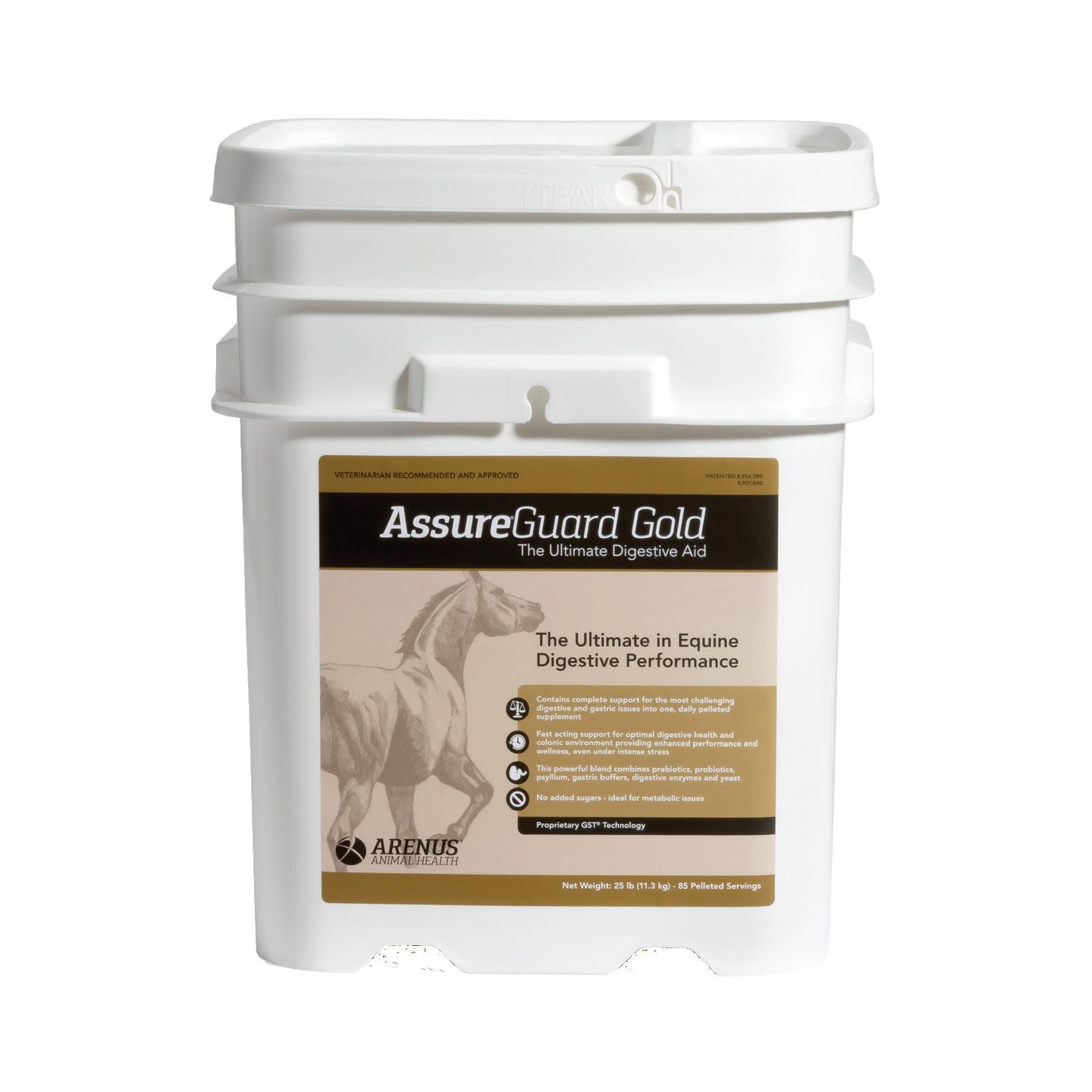

Around 60 to 70% of horses suffer with some level of digestive disturbance.
Researched and veterinarian-approved AssureGuard Gold provides powerful digestive support in an easy-to-feed, daily pelleted formula.
Our proprietarily processed psyllium and special enteric coated pellets ensure delivery of beneficial microbes and other key ingredients to the hindgut, where they are most effective.
AssureGuard Gold’s patented formula works to support the entire digestive tract, from the stomach to the hindgut, offering a complete solution for common digestive challenges.
have been to one, Brinsfield said, but she tries to give them a “ballpark time.”
“I give them a time to arrive at the showground and tell them to check in with me before they start to tack up the horse so I can let them know if their class is running on time or not,” she said, adding that she handles all class registrations.
Although it’s natural to have dreams of going home with blue ribbons, Brinsfield reminds her junior riders to set realistic expectations and soak up the experience, telling them: “This is your show to learn. Don’t expect to win.” She also stresses the value of practicing for future success, and that “this is a learning experience, and you also need to learn to lose.”
“I have a rule — they can cry if they get hurt, but they can’t cry because they didn’t win,” Brinsfield said.
The cost of equestrian clothing can add up at the best of times, even more so when kids outgrow their show clothes every season. An efficient way to reduce costs is to shop at consignment stores, with the added bonus that you can then re-consign items back to the store once they no longer fit.
“In our store, we take almost every single riding brand, from your ultra-high end to the more affordable options. You’ll find our prices are typically 25 to 80 percent off retail, so a lot of times you can get those high-end brands for the price of everyday clothes,” said Taylor Hall, owner of Tried Equestrian in Newhall, Calif., which also has a large retail website (80 percent of their sales are online purchases). There are a number of other consignment stores around the country, and many local tack stores also have designated consignment sections, Hall said.
“We have a lot of kids who buy their first show outfit from us, then outgrow it and consign it back and buy a new outfit,” Hall said. “We have actually worked with Olympians and Grand Prix riders who consign with us. We see their stuff come in and it then moves on to its next life without the buyer knowing where it came from, I call it the ‘Sisterhood of the Traveling Pants.’”
Maximizing how long clothing will fit a child is a great way to keep shopping bills down. “We recommend a little extra room in the jacket, so they have opportunity to grow into it,” Hall advised. “An easy tip is if it fits their waist nicely, then it’s OK if it’s a little bit long. You can also fold the cuffs under and do a small stitch that can then be taken out when they grow, to extend the life of the jacket a little bit,” she added. While tall boots that are too big are a safety concern, you can reduce a boot by a half or full shoe size by adding insoles and then take them out when the child’s feet grow. Hall also advises against spending money on fancy show shirts, as they are barely seen under the jacket. “You just need something white that fits around the neck well,” she said.
Riders should always wear a belt as they can lose points in certain classes if their shirt becomes
untucked. Hall suggests choosing a stretchy belt that can adjust from a child’s size small to an adult large, therefore it will never be outgrown. While most show clothes come in conservative colors, “Socks are a cute way for kids to add some fun colors and patterns under tall boots or breeches,” Hall said.
Hall warns against ever buying used helmets or blowup vests, however, and Tried Equestrian does not sell them for liability reasons. “Even if someone says a helmet has never had a fall, there’s so many little things that could happen to reduce its protection,” she said.
Younger riders should wear garters, short boots and bows.


Zen Elite Equestrian Center, located in Southwest Ranches, Florida is everything the name suggests and much more.
The state-of-the-art facility hosts a spacious covered arena, two huge outdoor arenas and a full rehab/spa.
From the cascading waterfalls in the rider’s lounge, to its peaceful statues and inviting gardens, Zen Elite Equestrian Center envelops visitors in a spa-like relaxed atmosphere.
But Zen Elite is more than just soothing to the soul. The facility is unique in its scope, hosting grassroots dressage and jumping lesson programs in the same arenas where international trainers are preparing for national and world competitions.
Owner, Heidi Humphries’ vision is legendary, in that it supports the future of horse sport in the spa-like serene atmosphere that is Zen Elite Equestrian Center.

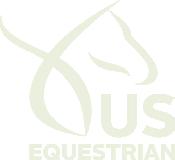


With these show ring essentials, horse show rookies will be ready for whatever the judges ask of them.

Tech and Traditional
The Kids Ice Fil® Knee Patch Jodhpurs from Kerrits are made with Ice Fil® fabric that adds high-tech cooling power to this classic style. Adjustable/removable stirrup straps and GripStretch™ Suede knee patches ensure a comfortable fit. $79; kerrits.com

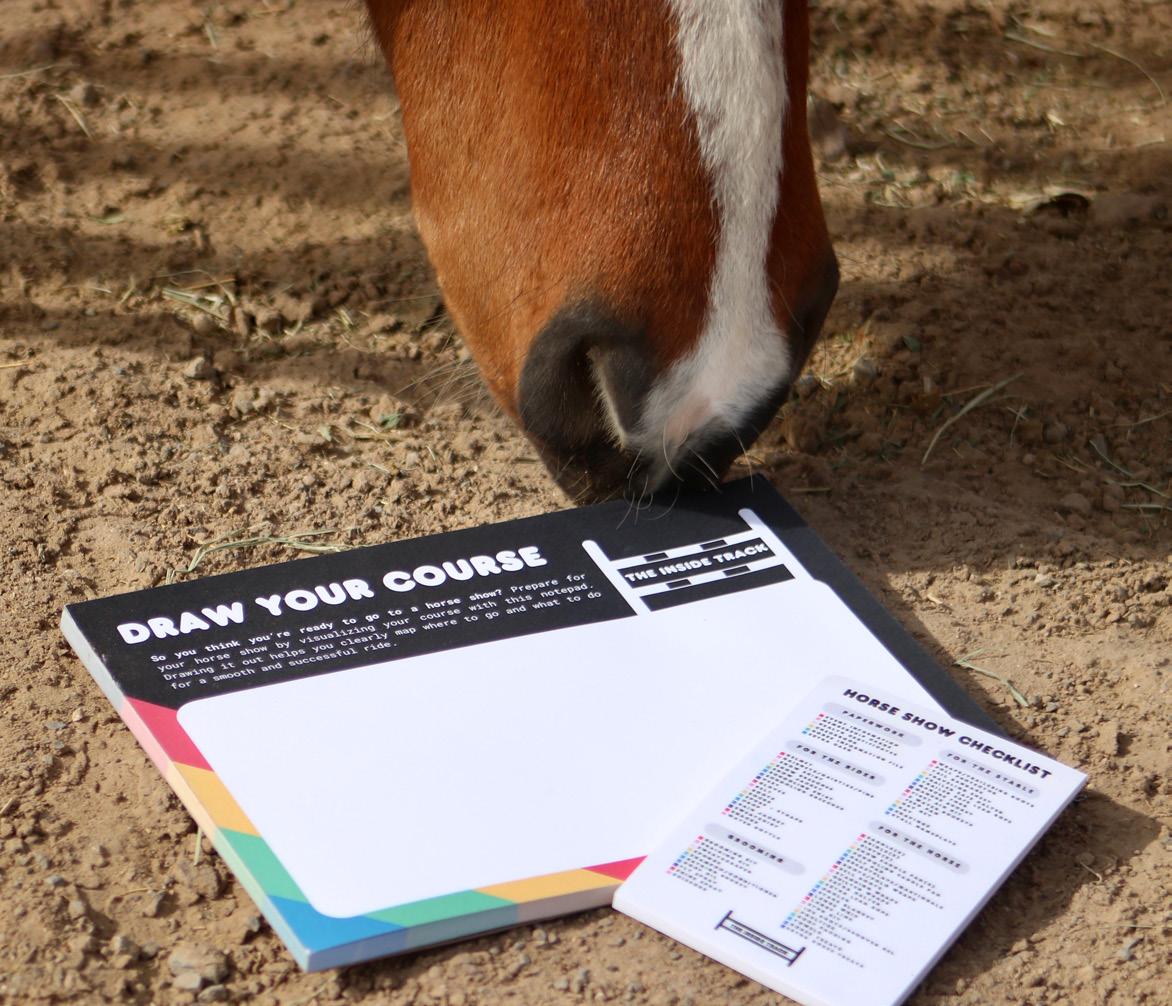
A Dash of Pattern Ariat’s Sunstopper 3.0 Pro Show Shirt is designed to keep young riders cool and comfortable in the warmup ring and also be dressy enough for a ribbon ceremony. The collar and cuffs feature a fun print that can either be revealed, or hidden when snapped closed. $64.95; ariat.com
The Inside Track’s mission is to bring the power of journaling and planning to equestrians. Young riders can prepare for their show ahead of time with the Draw Your Course and Test notepads, allowing them to visualize and memorize jumping courses or dressage tests. The Horse Show Checklist Sticky Notes ensure there are no lastminute packing panics or forgotten items. Draw Your Course/Test Notepad: $18.99; Horse Show Checklist Sticky Notes: $12.99; theinsidetrackshop.com



Dapplebay’s new Shine On Jump Saddle Pad adds dazzle and a dash of sparkle to your tack ensemble. Designed by influencer Marina Layton, the white pad boasts a dirt-repelling top layer to keep it clean, and a soft, non-slip underside for your horse’s comfort. Complete the collection with the Shine On fly veil, which has “eyes up” embroidered on one ear, and “heels down” on the other. Pad: $79.99; Veil: $49.99; dapplebay.com

The Kylo helmet from Charles Owen offers style, comfort - and most importantly - protection thanks to three international safety standards and optional Mips technology. The dial-adjustable precision fit ensures that the Kylo always stays secure on growing heads, while the machine-washable wicking fabric removable headband is easy to clean. $145-185; charlesowen.com
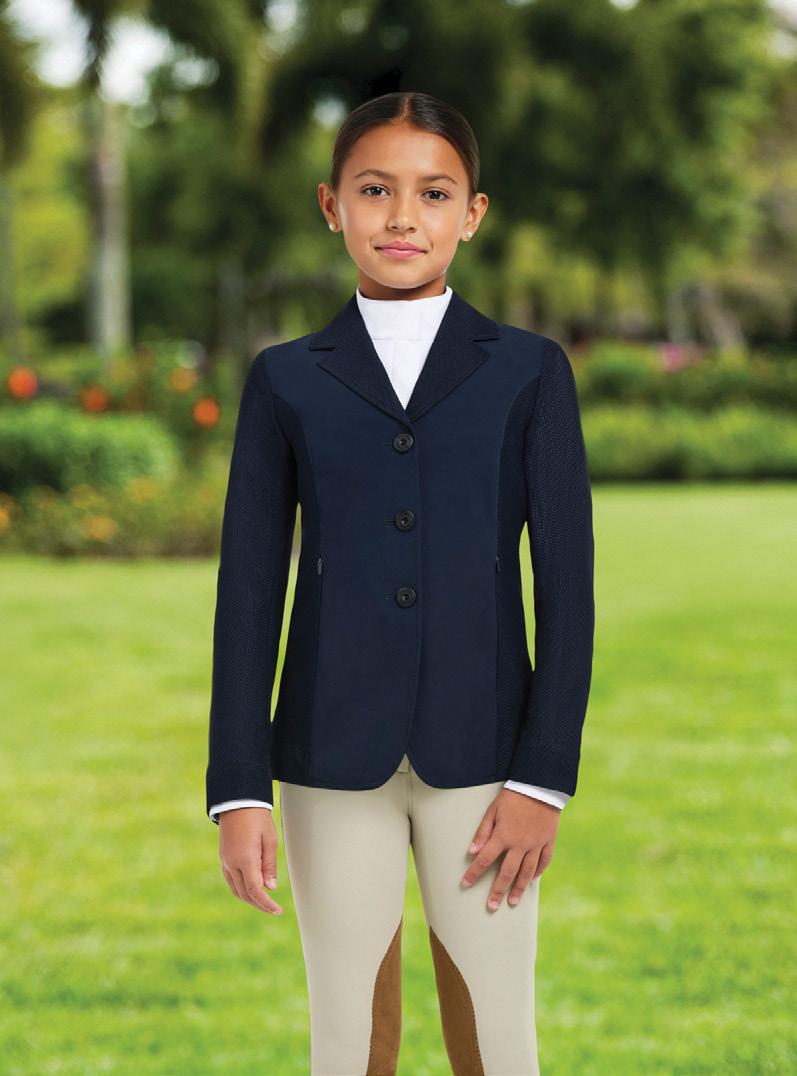
The R.J. Classics Girls’ Harmony Jr. Mesh Show Coat 2.0 from Dover Saddlery delivers the luxury of the brand’s bestselling women’s coat in junior sizes, offering young riders a more relaxed fit than the original Harmony Jr. Made with a lightweight mesh body fabric and Italian jersey front panel, this coat is guaranteed to turn heads in the show ring. It features vertical zippered pockets, a hidden front zipper topped by branded matte buttons and three-button cuffs. Available in navy. $249; doversaddlery.com





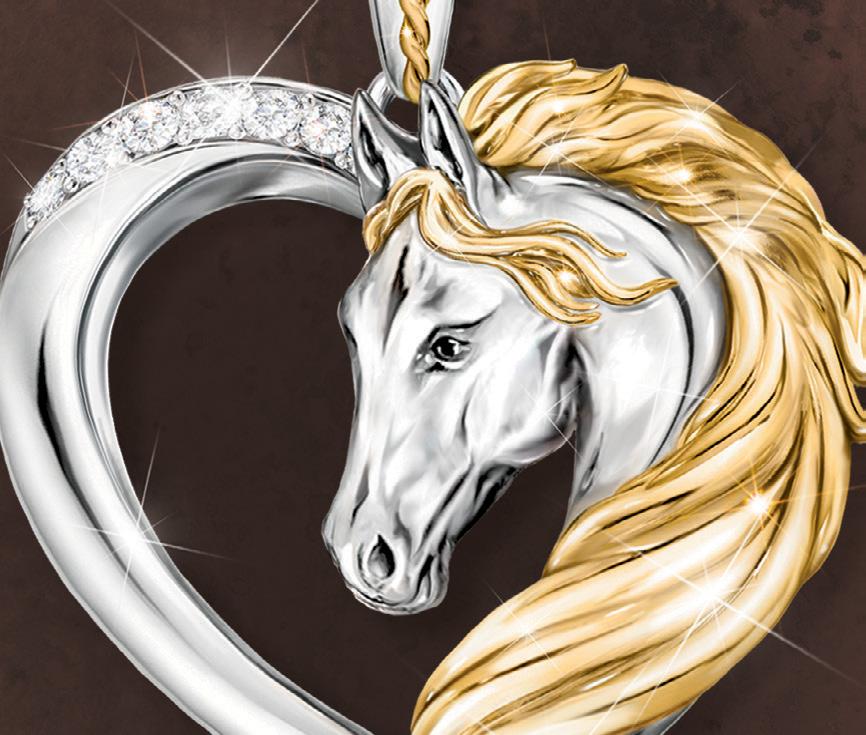

Whether they’re galloping through open pastures or following your lead at a slow gait, horses are like beautiful poetry come to life. Beautifully hand-crafted with gleaming platinum plating and 18K gold plating, this heart-shaped pendant features an intricately sculpted horse with a owing mane and lifelike details. A pavé of clear crystals at the top and bottom—a total of 8 crystals—add a shimmering touch. The bail showcases a gleaming twisted rope design, evoking thoughts of taking the reins of a beloved horse. This pendant suspends perfectly from a matching 18" chain, making it a perfect gift for any equine enthusiast.
Today at


A Remarkable
With its exquisite craftsmanship, delicately sculpted design, and dazzling crystals, the “Gentle Spirit” Horse Pendant is an outstanding value at just $79.99*, payable in 3 easy installments of $26.66. Each pendant arrives in a deluxe velvet jewelry pouch that’s perfect for gift-giving or safekeeping, along with a Certi cate of Authenticity. To reserve this breathtaking pendant for yourself or for someone in your life, send no money now; just mail the Priority Reservation. Don’t miss out; order today!





“My
Hers”
by Tamie Smith
Eventer Tamie Smith and her daughter, Kaylawna Smith-Cook, inspire each other even when riding in the same competition, and dream of one day being on a U.S. team together.
When I had my daughter, Kaylawna, at age 19, I had no idea that my equestrian career would turn into what it ultimately did. Initially it was just me and Kaylawna — I was a single mom working a full-time job, going to school to get my degree, riding, and bringing her to the barn with me. I don’t necessarily feel like I even had a clue about what was transpiring at the time. I was in complete delusion! Horses were very much a saving grace for me and a place where I felt safety and sanity. Back then, I still had hopes and dreams of riding in the Olympic Games. Even though I have always had a ridiculous work ethic, at the time I was basically still a kid myself and had no idea of what that would entail.
I would pick Kaylawna up from daycare after school and we would drive out to the barn. She was in her stroller and would wait with whichever horse I was tacking up. I would then wheel her out to the arena and ride. Even though Kaylawna was at the barn with me all the time while she was growing up, I always wanted to make sure that I didn’t push riding on to her, as I never wanted to make her feel like she had to follow in my footsteps.
Fortunately, my horse family helped me get to where I am today. While I was raising Kaylawna, she would come with me to horse shows and everybody knew her as “Tamie’s kid.” She quickly made fast friends but was not super serious about riding at that age. She rode all throughout her youth on Pepper, a pony that I grew up riding. Pepper taught so many generations as my mom also learned how to ride on him. He was the perfect kind of the pony — 14.2 hh and as wide as he was tall! As soon as Kaylawna got to the barn, she would run up to Pepper and groom him. It was a very active training barn, and the people were mostly adult amateurs. Kaylawna convinced them that she needed help grooming and tacking up Pepper. If she could get somebody to help her,


Roeck-Grip® Lite gloves are made with Roeckl's exclusive Roeck-Grip® material that provides soft, breathable comfort on hot summer days! Like Roeck-Grip and Roeck-Grip Winter, the Roeck-Grip Lite fits like a second skin, giving the rider a close contact feel, and is even touchscreen compatible! Roeck Grip Lite gloves are available in Black, White, and the new Naval Blue!
then she would ride. Whereas I was always of the mindset that if she couldn’t do it herself, then she couldn’t ride. For many years, I thought Kaylawna was the one that was tacking up Pepper, when in fact it was the entire community at the barn helping her!
Once I started training other people when Kaylawna was 12 or 13, she got more serious about riding. My niece developed a strong interest in horses, so Kaylawna started coming out to the barn with her and they later competed together. Kaylawna is such an athlete and has a natural talent. She didn’t have many formal lessons throughout her childhood until her late teens and just rode and watched until then, soaking everything in. While in high school, she played competitive sports like water polo, volleyball and swimming, and was on the varsity teams so she didn’t ride much during that time. Then in January of her senior year, she announced that she wanted to go to Young Rider Championships, as it was her last chance as an 18 year old to qualify. I thought she was crazy! We didn’t have a horse, and she hadn’t ridden in four years. I thought she was set up for failure, but I said I’d support her. I had a client’s horse in my training program that was getting ready to move up to the Preliminary 2-Star level, so we leased him for Kaylawna to ride. She qualified and made the team — and finished in the Top 10 overall, and was the only person on her team to finish the cross country. After that, I thought, “if she wants to do this then she has definitely got the attitude and the talent.” I was trying to spare her from the disappointments involved in high performance sport, but she wouldn’t let me. She’s got the grit, and she’s got the drive, there’s no stopping somebody like that because the heart wants what the heart wants.
“RESILIENCE IS A MASSIVE REQUIREMENT IN THIS SPORT, YOU HAVE TO KNOW THAT IT’S HARD AND THERE’S GOING TO BE CHALLENGES.”

I encouraged her to seek out work with a specialist, and she went to go work for Nicholia Clarke, who is a high-performance dressage rider. Kaylawna worked for her for a few years and got to ride up through the Intermediate level in dressage, although she ultimately ended up coming back to eventing because she loved it so much. I told her that she had to start where everybody else does and didn’t give her any special privileges. She had to earn every bit of her place in the program. She rode young horses and was a working student for about five years. I found horses for her to ride to gain experience with until I felt like it was time for her to venture off onto a path where she could be on her own and produce her own horses.
It’s evolved into her now having her own program. It’s something I really pride myself on because I’ve watched her go from nothing to having such a strong group of young horses that she’s producing with a great level of support from the owners. That’s not easy to acquire in this sport, especially at the early stages of her career at age 28. We keep our horses at the same facility in Temecula, Calif., but she is very much a separate entity even though I mentor her and give her advice in terms of managing the training program and connecting her with the right kind of people. From the outside looking in, I’m sure it looks like all rainbows and fairy tales, but there is an element to this that has been quite challenging, as anybody would expect to be in business with your own child. She mostly gets her training from trainers who I ride with. I try to really stay separate and act as a supportive mother, more than her coach.


Kaylawna has been there every step of the way with me, my disappointments and my successes were also hers. I’ve been able to help her get to a better place sooner than I did because she’s learned from my trial and error. As anybody who’s followed my career knows, it hasn’t been easy! It’s been one hurdle after another, so she’s been able to see that. To watch her still have the desire and drive to do it knowing what she has potentially in store for her, I half think she needs her head examined! But I also admire it, resilience is a massive requirement in this sport, you have to know that it’s hard and there’s going to be challenges.
I get more nervous watching her compete than competing myself, as I want her to succeed so badly and never have to go through the hurt and turmoil that I did. The amount of emotions and nerves involved is extreme. We have already done many competitions competing against each other. It was hard at first half because I was paying attention to what she was doing on course while I was on course. I’ve gotten used to it and now I’ve learned to compartmentalize, and make sure I am in my own headspace. I can’t control everything, I can provide her with the information, but ultimately, she’s going to learn when it’s her time.
My goal for the future is to be able to compete together at a 5-Star, and also, potentially on a U.S. team. I feel like that would be such a cool, history-making achievement. Overall, I see really big and exciting results in Kaylawna’s future and I’m hoping she achieves even more than I have so far.
By Kaylawna Smith-Cook
I don’t think there was one specific moment when I decided I wanted to follow in my mom’s footsteps as an eventer. Growing up around the barn and watching my mom compete inspired me, and I knew from a young age that I wanted to compete, but it wasn’t until after high school that I chose to do this professionally. I saw firsthand the dedication, resilience, and passion it takes to succeed in this sport. Watching her highs and lows taught me so much about the reality of being an athlete and has given me a deep appreciation for the journey. My mom is an extraordinary person, both in and out of the horse world. I’ve witnessed her heartache, her successes, and everything in between. What’s stayed consistent is her drive to never give up. I’m so proud of her and grateful to learn from her every day.
The biggest lesson my mom taught me is to always remain a student of the sport. No matter what results you achieve, you should continue striving to be better

every day — and you are never above chores, cleaning stalls, grooming, etc. That mindset has stuck with me and shaped the way I approach everything I do.
The best thing about competing in the same sport as my mom is the uniqueness of our situation. I’ve always dreamed of being at the top of the sport alongside her, and I feel like that dream is getting closer every day. It’s incredibly special to share this journey with her. I don’t see it as competing against her as I think I’m my own biggest competiton. My focus is always on improving my own results and becoming better than I was in the last competition. My personal goal is to represent Team USA on senior teams. A shared goal with my mom is to be the first mother-daughter duo to compete in a 5-Star event together. I’d also love for us to be on a senior team for the U.S. someday — that would be an incredible milestone.
My daughter, Kennedi, is four years old and my dreams for her are simple. I want her to understand the meaning of family and to appreciate the people around her. I believe good morals and a simple, grounded mindset can take you far. Through our family, she’ll have incredible resources in so many areas, and I’m ready to support and guide her in whatever path she chooses to take.

by Zack Ryle
Proactive prevention policies foster a culture of awareness and vigilance, so that concerns can be addressed before they escalate.
Each new competition year brings new opportunities for athletes in our sport. As we turned the calendar from November to December last year, important additions and revisions were made to several documents within the safe sport department at US Equestrian.
In December 2024, the U.S. Center for SafeSport made revisions to their Minor Athlete Abuse Prevention Policies (MAAPP), which the US Equestrian Federation mirrored in their most recent iteration of the MAAPP.
The MAAPP is a collection of proactive prevention and training policies to help create a safer and healthier environment in which minor athletes can thrive. The MAAPP
includes prevention policies for electronic communications, transportation, lodging, meetings and individual training sessions, manual therapy and therapeutic and recovery modalities, and locker rooms and changing areas.
“These robust proactive prevention policies help foster a culture of awareness and vigilance, and they enable early intervention and the ability to address concerns before they escalate,” stated US Equestrian Chief Operating Officer and General Counsel Sonja Keating. “The policies include specific requirements designed to prevent abuse, misconduct, and other forms of harm before they occur. By limiting the one-on-one interactions between adults and minor athletes, the ability to engage in grooming behaviors for instance, is removed.”
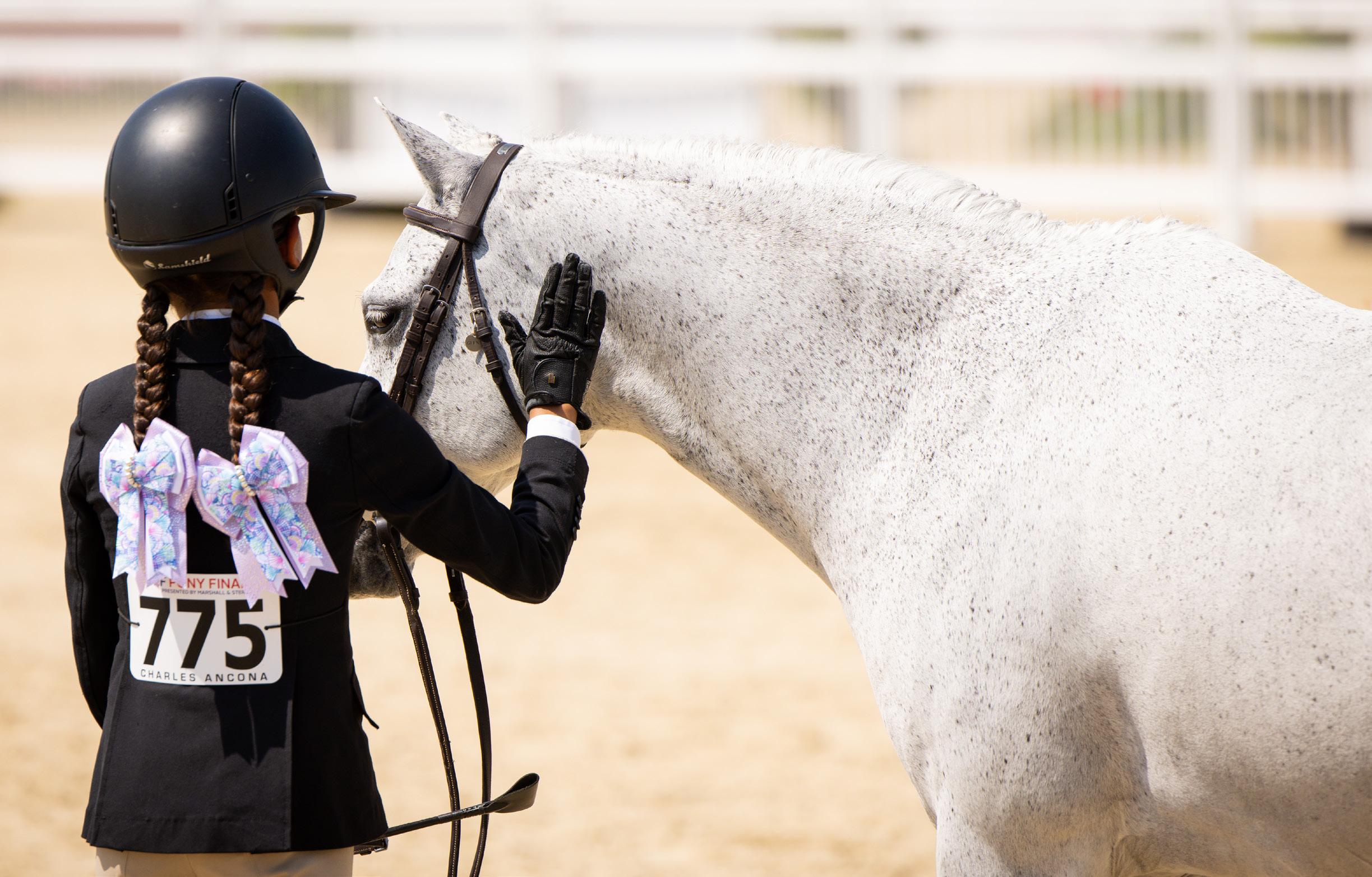
“The revisions to the electronic communications, lodging, and travel policies are crucial for the safety of our junior equestrians,” stated US Equestrian Chief Operating Officer and General Counsel Sonja Keating.

“Our aim is to cultivate and nurture a safe environment for all equestrians to train and compete,” Keating continued. “By regularly updating our policies to respond to evolving needs and emerging risks, we ensure that our practices are aligned with the highest standards of safety and protection.”
1. Electronic Communication Policy
The revised MAAPP aligns the policy so that the requirement is the same for direct and team communication. When an Adult Participant communicates electronically with a minor athlete, or with any number of minor athletes, they must copy or include the Minor Athlete’s parent/guardian(s), another adult family member of the Minor Athlete(s), or another Adult Participant on every communication.
2. Transportation Policy
An age requirement of eight years old for minors is now added to the revised MAAPP, such that an Adult Participant meets the In-Program transportation requirements if the Adult Participant is accompanied by another Adult Participant or at least two minors, who are at least eight years of age.
3. Lodging Arrangements
The revised MAAPP expands lodging arrangements to include other common residential environments used within the Olympic and Paralympic Movement. Additional arrangements added to the lodging policy include rentals and long-term residential environments, including lodging at training sites and billeting.
The following definitions have been added to the MAAPP to further clarify Lodging and Residential Environment policy requirements:
• Residential Environment: A place in which participants live or stay tem porarily. Residential environments include, but are not limited to, onsite housing at training facilities, billeting, hotel stays, or rentals (i.e., Airbnb, VRBO, HomeToGo, etc.).
• Billeting: A residential environment facilitated by an Adult Participant, USEF or the USOPC, or sanctioned event staff in which a Minor Athlete is temporarily housed in a private home with an adult or family
who is not related to or known by the Minor Athlete. This lodging arrangement is in conjunction with an activity related to sport. This may include working student relationships where the working student resides on site.
4.
For meetings with licensed mental health care professionals or licensed health care providers, the revised MAAPP now includes individuals who are completing a supervised practicum, internship, or field experience within the Policy, which permits them to meet with a minor athlete one-on-one for treatment.
5.
The revised MAAPP adds a requirement that the provider must narrate the steps in the modality before taking them, seeking assent of the minor athlete throughout the process.
6.
A clarification was provided on how to determine the four-year age difference.
7. SafeSport Training Exemptions
Exemptions for the online SafeSport training requirement were expanded to include cognitive or physical disability or language barriers (in addition to survivor of abuse and misconduct).
“The revisions to the electronic communications, lodging, and travel policies are crucial for the safety of our junior equestrians,” said Keating. “Most safe sport reports we receive pertain to these three areas. These updates support our mission to provide access to and increase participation in equestrian sports at all levels by ensuring fairness, safety, and enjoyment.”
Updates were also made to the Sample Consent Forms for the MAAPP that allow parents or guardians to authorize permitted exceptions to MAAPP requirements. The U.S. Center for SafeSport provides resources including model consent form templates to support trainers and coaches in meeting their obligations under the MAAPP. These can be found at maapp. uscenterforsafesport.org/resources/.
Another change that was a part of the revision process included an expansion of the definition of “regular contact” to include any amateur athlete who is a minor.
Learn more about the updated MAAPP and these noteworthy revisions at usef.org/ maapp. For reporting MAAPP violations go to usef.org/safe-sport/reporting

for minor athletes.
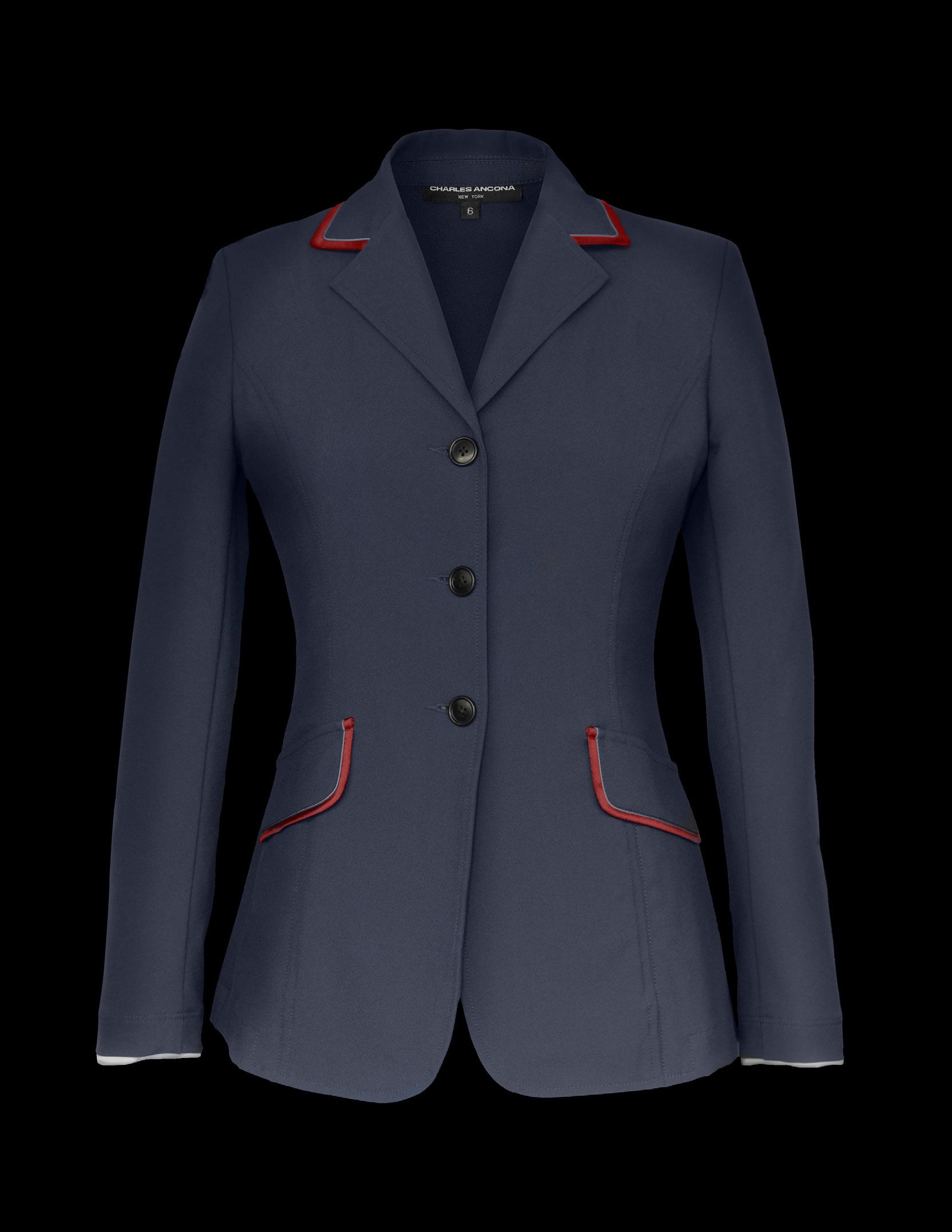
NEW YORK
CUSTOM FIT & DESIGN
Dress for whatever weather spring delivers with Ariat’s versatile equestrian wear.
The weather in springtime can be notoriously unpredictable, ranging from gloriously sunny days and April showers, to frost and even snow in some areas of the country. One week you might need warm layers at the barn, and the next week you’re sweating and worrying about sun exposure. That is why products are essential components of your spring wardrobe. As a performance-based brand, Ariat is always looking for fresh ways to develop new styles that meet the needs of equestrians to allow them to work, compete, or train at their very best in a variety of environments. This involves the use of groundbreaking technologies and fabrications that take clothing to the next level of innovation. Whatever your day holds in store and whatever the weather, the iconic brand has a look
A top pick amongst Ariat athletes, the Meridian X Show Coat is the coat of the season – and of all seasons! - thanks to ClimateTEK that responds to your body temperature to keep you cool when the temperatures rise. FreshTEK makes it odor-resistant, and a stain-repellent finish helps to ward off horse show dirt. Style-wise, the X is an evolution of the popular Meridian Show Coat, with the addition of antiqued silver details and subtle black crystal embellishments. It maintains the original design’s close-to-the-body fit and immaculate tailoring that turns heads in the show ring.

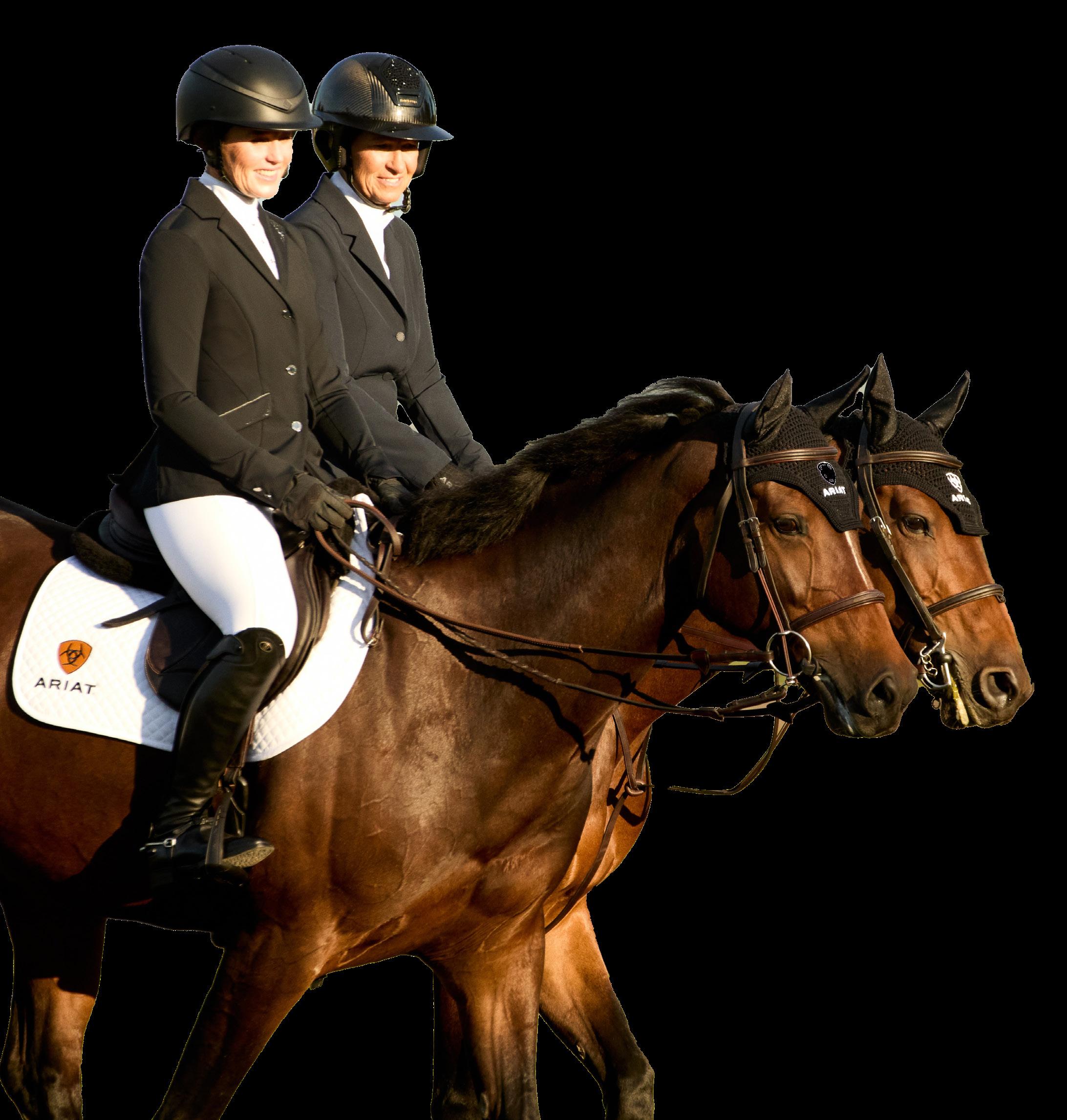

The philosophy and technology of Ariat’s Breathe collection can be experienced with the Breathe Half -Zip Cap Sleeve Baselayer. Made with recycled fabric, the cap-sleeved baselayer has mesh sides to aid cooling while riding or doing barn chores. It incorporates Sun Protection Fabric™ for UV coverage; ClimateTEK™, which responds to your body temperature to keep you cool when the weather heats up; and FreshTEK™ to resist odors when life gets sweaty. A half-zip stand collar ensures that the Breathe baselayer, which is available in Plum Grey or Tulipwood, is both classy and functional.
The Luxe 2.0 Show Shirt is also an enhancement of an Ariat favorite. It is made of Sun Protection Fabric for ultimate UV coverage on hot show days, along with ClimateTEK to stay cool and FreshTEK to keep you smelling sweet! The pintuck bib front and refined, technical mesh fabric ensures the Luxe 2.0 fits smoothly under any show coat, and a stock tie loop at the back of the collar means that it is flexible for a variety of disciplines. The design is topped off with a show collar and cuffs. The Luxe 2.0 Show Shirt looks equally as stylish when paired with a jacket or worn alone, which provides flexibility while waiting in between classes.
The Tri Factor Grip Knee Patch Breech brings Ariat’s cooling technology to your lower body. The ClimateTEK cools you down when the day heats up and Moisture Movement Technology once again helps keep you dry. Meanwhile, the compression fabric and Core Control Technology™ offers slimming support, and the Calf Fit System™ provides calf compression so that your lower legs can fit snugly into tall boots. The Ariat V3® waistband enhances the close fit silhouette while also allowing stretch for ultimate movement. The ingenuous breeches (pictured in white) even aid your riding form as the Ariat Hex Silicone Grip knee patches have a textured surface that helps you stay securely in the saddle.
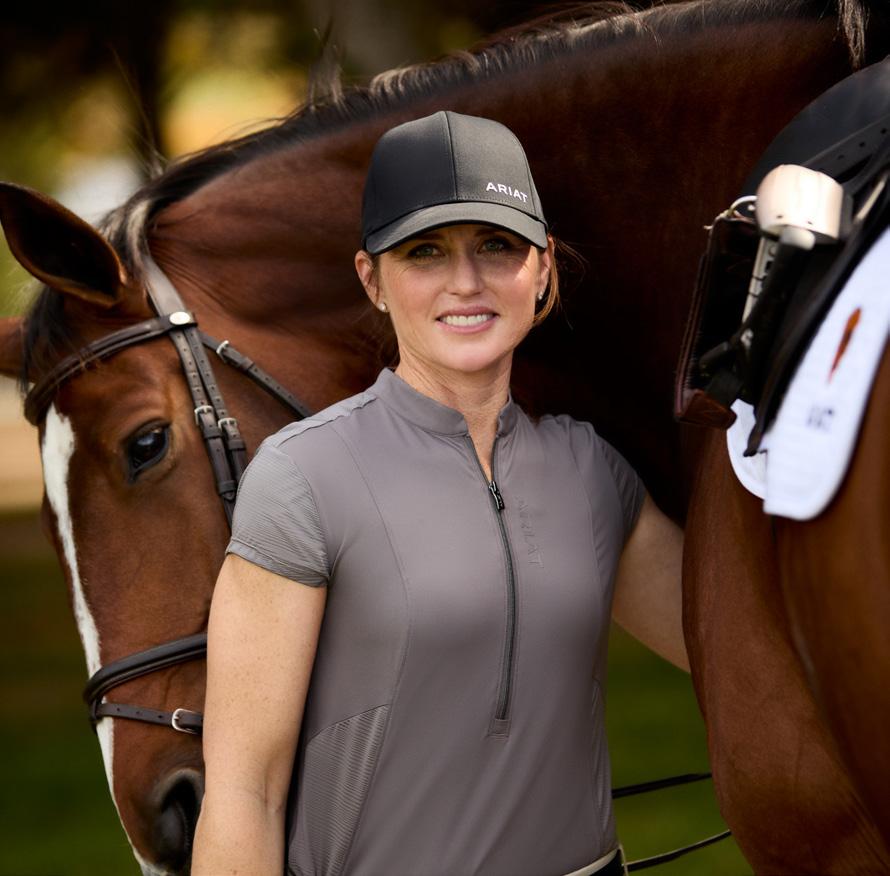


Research-based supplements to support your horse’s performance.
Goal Supplement
Maintain healthy muscle and nerve function. Support a strong immune system while traveling.
Sustain a robust microbiome and maintain normal stomach and hind gut pH levels.
Support normal hydration levels and replace lost electrolytes.
Support weight gain with cool energy.
Maintain fluid motion and flexibility in joints.
Support a relaxed, focused attitude.
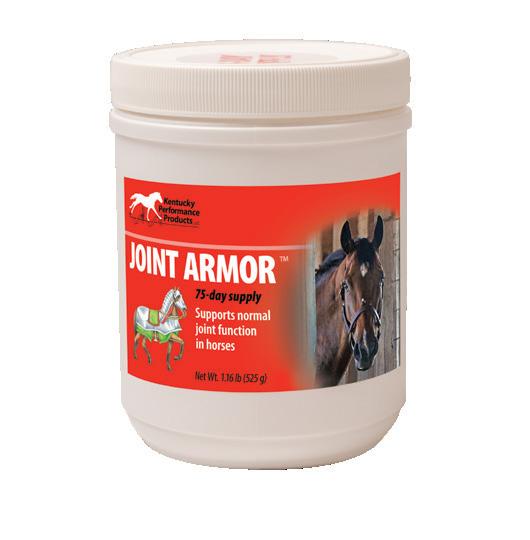


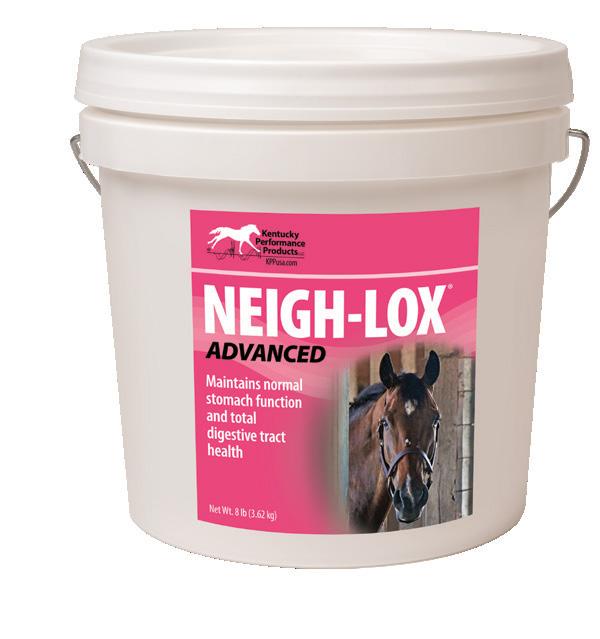

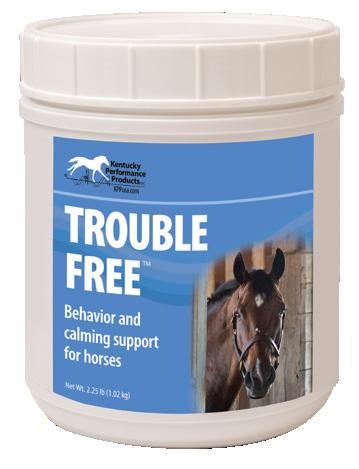


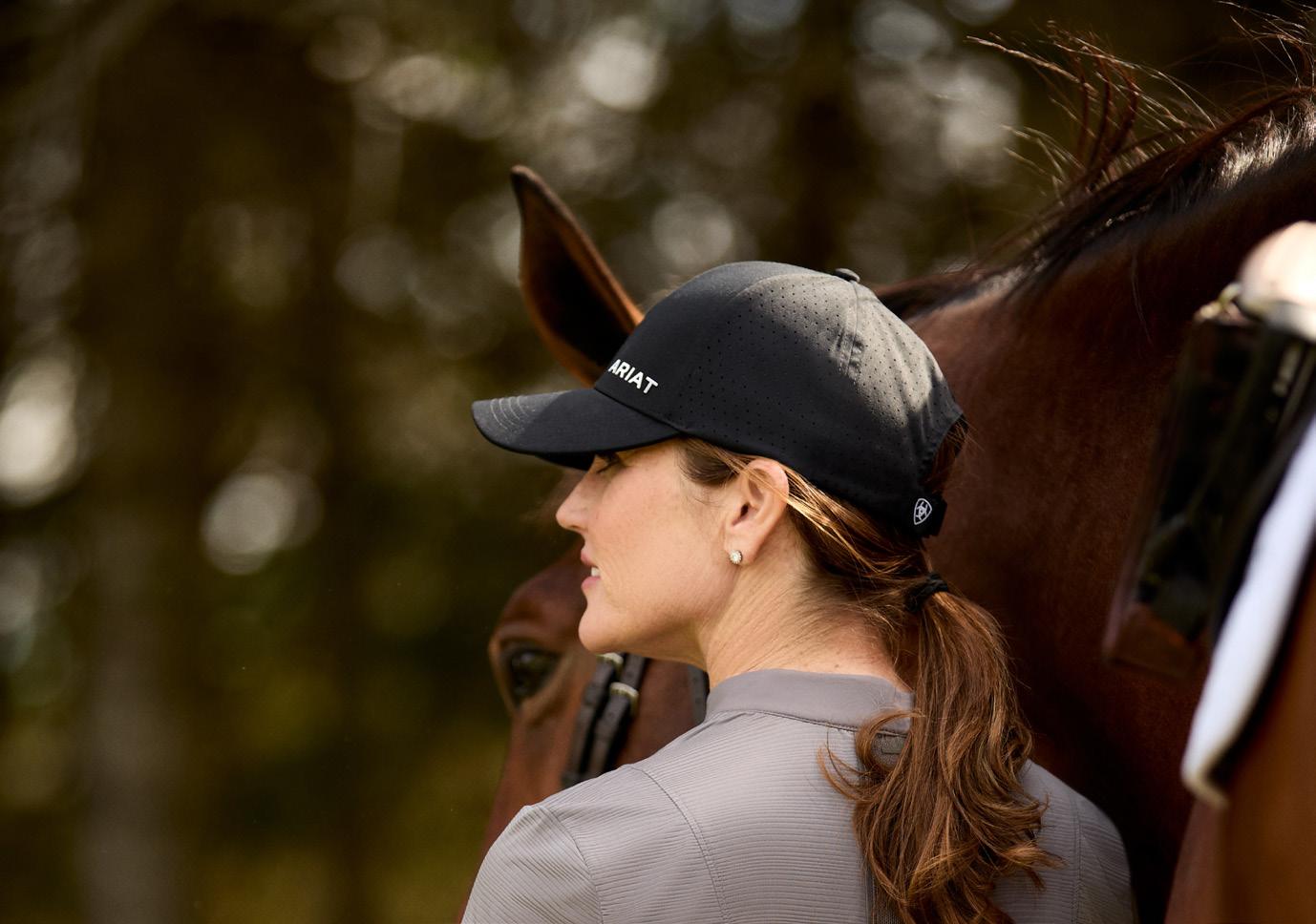

The Ariat Breathe Cap will shield both your face and your eyes from bright spring sunshine, which is especially important if your skin hasn’t seen the sun all winter long. The stylish black cap features cooling fabric in the headband and has perforated panels for breathability to prevent overheating from the head down, while also offering UV protection. A back slider clasp ensures that the adjustable unisex cap really does fit all. The Breathe Cap is made of 100 percent Recycled Polyester Twill, so it is ecofriendly as well as fashionable.
The Palisade Lace Tall Boot not only looks sophisticated, but it also offers extra comfort for long days in the saddle or walking around showgrounds. The full lace front and removable insole let you fully customize and adjust the fit, while cushioning and supportive 4LR™ technology keep feet snug and stable. The Palisade also features a full-length elasticized panel on the lateral side and an elastic gusset on the inside knee to enhance mobility. A Spanish topline, modern branded hardware, and subtle saffiano print complete the Palisade’s stylish yet functional design.
The Breathe Half-Zip Sweatshirt is the ideal layer for when mornings are crisp and cool, but the weather warms up once the sun rises. The lightweight sweatshirt with a half -zip is the perfect marriage of breathability and coziness for those in-between seasons. The Breathe sweatshirt also features the best of both worlds when it comes to Ariat technology — combining Moisture Movement Technology™ to keep you dry, and Sun Protection Fabric to protect from UV rays when the skies are clear. Pictured in Plum Grey, it features the Ariat signature branding down the back and on the thick, sporty cuffs. Deep kangaroo pockets can store riding essentials ... or horse treats.

Christian Kukuk and Checker 47 jump to victory in the $750,000 Rolex US Equestrian Open Grand Prix CSI5 at Wellington International.

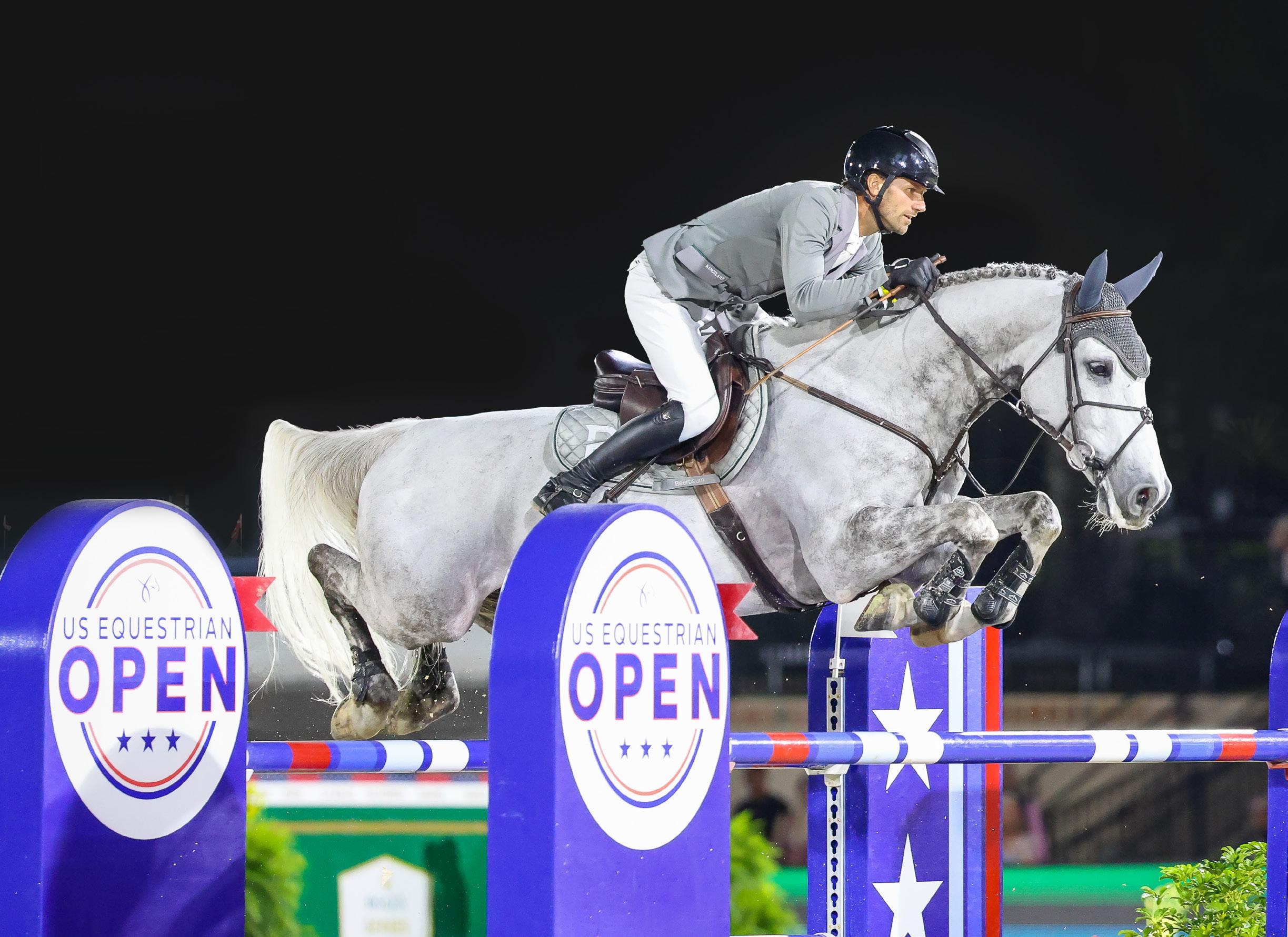
The first final of the new US Equestrian Open series brought the best of the sport — and a sold-out crowd — to Wellington International, Fla., on March 29.
BY US EQUESTRIAN STAFF
In front of a sold-out crowd and in a palpable atmosphere, Christian Kukuk (GER) and Checker 47 bested the class of 40 world-class entries to take top honors in the $750,000 Rolex US Equestrian Open Grand Prix CSI5*, a Rolex Series event. Kukuk, who is coming off an incredible 2024 competition season with Checker 47, hoisted the US Equestrian Open trophy atop the podium in the inaugural US Equestrian Open Jumping Final, etching their names into history.
Laura Kraut (USA) and Bisquetta finished as the highest-placed U.S. combination on the podium, earning second overall, while Ashlee Bond (ISR) and Donatello 141 rounded out the top three.
The beautiful course design by Guilherme Jorge (BRA) showcased the athleticism, scope, and smarts of the 40 qualified ombinations, putting top sport on full display in the final major grand prix of the winter season at Wellington International.
“Checker and I have known each other for five years. We’ve created a relationship full of success and disappointments.” said
Kukuk, “It’s been two years now since I have learned every single one of his ‘buttons’ you could say. I know exactly what I can ask of him and what I cannot. He knows me, he trusts me, and we trust each other. To be consistent in this level of competition, it’s all about creating a deep relationship with your horse.”
The class saw rails fall throughout the track, with combinations challenged by the technical precision demanded by the course design. Early in the order, Ashlee Bond (ISR) and her longtime partner, Donatello 141, earned the first clear round of the night, followed quickly by Carly Anthony (USA) and Heavenly W, who also notched a clear round within the first four rides of the class to guarantee an exciting jump-off.
The first half of the order saw some class favorites drop from contention with world number one-ranked Henrick Von Eckermann (SWE) and King Edward adding an early four faults, while U.S. talents Karl Cook (USA) and Caracole de la Roque just
nudging a rail to add four to their score. Jordan Coyle (IRE) guided Chaccolino to a clear round as the thirteenth combination to test the track, followed shortly by Rodrigo Pessoa (BRA) also jumping clear into the jump-off with his Paris Olympic mount, Major Tom.
“To have the quality of riders we have now – Olympic champions, world champions, world number one - and to draw the crowds we have, it just shows this sport is a spectator sport and there are fans that want to be a part of this,” said Michael Stone, President of Wellington International. “To see the kids get so excited to get autographs and photographs with athletes like Laura [Kraut] and Christian [Kukuk] is special. It’s so important that we bring the sport to everyone. We want to help in growing the sport and this event has set an incredible mark for how we can do that and the kind of people and passion we can get behind it.”
Following the ring maintenance break, U.S. veteran Laura Kraut stamped her mark aboard the quick Bisquetta, producing a fast clear ensuring two U.S. combinations would move forward to the jump-off. Just on the foot of Kraut’s clear, Bertram Allen (IRL) and Qonquest de Rigo, produced another efficient effort, bringing the jump-off total to six combinations.
“I have to say the crowd here has been amazing all season, but tonight was just extra electric,” said Kraut. “When we did the autograph signing after the awards, I was thanking everyone – they were just the best fans tonight. We all felt it and it’s fantastic show jumping. Gui [Jorge] did an incredible job with this course and there were just tremendous combinations out here tonight. This was really a highlight class for all of us.”
The second half of the class proved to challenge many of the seasoned favorites coming later in the order with McLain Ward (USA), Kent Farrington (USA), and Ben Maher (GBR) all finishing with four heartbreaking faults in the first round.
After a drought of clears midway through the order, Olympic individual gold medalists Christian Kukuk (GER) and trusted partner Checker 47, produced a valiant and impressive clear as they looked to match McLain Ward as the only other athlete in history to win the class twice. The final pair to move on to the jump-off came with a spectacular round from Daniel Coyle (IRL) and his Paris 2024 mount, Legacy, pushing the second round to a total of eight combinations to return for the fast track.
In the jump-off, Bond and Donatello 141, a 2011 Westphalian gelding (Diarado x Lamoureux I) owned by Ashlee Bond Show Jumpers, LLC, and cared for by Zoe Hatgi, set a fast pace as the first combination out of the gates, crossing through the timers in 40.41 seconds. Anthony and Heavenly W, a 2011 KWPN gelding (Calvaro F.C. x Quidam de Revel) owned by Portfolio Horses LLC, and cared for by Pauline Homer, hit heartbreak in their course, as they were matched with Bond up until the last fence, when the pair encountered a miscommunication at the final oxer and ultimately needed to reapproach.
Coyle and Chaccolino, a 2011 Australian Warmblood gelding (Chacco Blue x Heartbreaker) owned by Elan Farm & Jordan Coyle, and cared for by Jorge Jimenez, finished just three-hundredths of a second behind Bond, crossing through the timers in 40.44 seconds to move into second.
In the last opportunity for a U.S. combination to take the win, Kraut and Bisquetta, a 2014 Belgian Warmblood mare (Bisquet Balou C x Takashi van Berkenbroek) owned by Cherry Knoll Farm Inc. and cared for by Margo Thomas, gave their all, with Bisquetta showing off her determination and fight, marking the fastest time yet, finishing in 39.49 seconds. Allen and Qonquest de Rigo, a 2016 Belgian Warmblood gelding (Fantomas de Muze x Indoctro) owned by Ballywater Stables LTD, and cared for by Lovisa Munter, had an early rail in their jump-off, but finished as the fastest four-fault combination to take fifth overall.
Christian Kukuk and Checker 47, a 2010 Westphalian gelding (Comme Il Faut 5 x Come On) owned by M.H. & Partner Gbr, and cared for by Sofie Karlsson, showed the depth of their incredible partnership together. The pair put on a masterful navigation of the short track to just nudge Kraut from the top of the leaderboard and stopping the timers in 39.2 seconds, earning them the win. Daniel Coyle and Legacy, a 2010 Zangersheide mare (Chippendale Z x Bon Ami) owned by Ariel Grange and cared for by Sue Braund, set out at a quick pace, but ultimately added 12 to their score to finish in eighth overall.
“It is a pleasure to ride Checker. There is something special between him and this arena. Every time I come into the ring with him, I get the feeling that he has an extra gear, he feels so comfortable here [in Wellington.] Sophia takes care of him every day and all this combined has made me the happiest man on the planet tonight.”
Kukuk also noted that he and his wife, Veronica, welcomed their first child, a daughter named Lila, into the world in the early morning hours of Saturday before the class, which is a moment that will memorialize this victory. “I’m really happy about the win today, but what happened this morning was a little more special. All of it together made this day something I will never forget.”
Learn more about the US Equestrian Open by visiting the US Equestrian Open microsite, powered by EquiRatings, to follow all of the qualifying and storytelling action throughout the year.
The US Equestrian Open Jumping Final is the first of the three finals to be hosted as part of the new innovative US Equestrian Open Series. The next final will be the US Equestrian Open Eventing Final hosted at Morven Park International in Leesburg, Va. from October 9-12, followed by the US Equestrian Open of Dressage Final to be hoested at Desert International Horse Park in Thermal, Calif. from November 13-16. The US Equestrian Open is proudly supported by Great American Insurance Group (GAIG), the official equine insurance agency of the US Equestrian Open Series.
“We want to help in growing the sport and this event has set an incredible mark for how we can do that.”
- Michael Stone, President of Wellington International




Left: Ireland’s Shane Sweetnam and James Kann Cruz cruised to finish 19th overall.
Bottom: Alex Matz and his top mount Ikigai attempted to capture a second CSI5* win together.

The US Equestrian Open brings together the best athletes and horses in the Olympic disciplines of eventing, dressage, and jumping for world-class competitions, substantial prize money, and global recognition. The series was launched to grow equestrian sport’s awareness, exposure, and fan engagement, while providing a structured and prestigious championship format. With a total of $1.25 million in prize money across the three disciplines, the US Equestrian Open enhances opportunities for athletes and creates thrilling events for spectators both in person and for those watching on ESPN and the USEF Network. It also aims to build towards the excitement of the Los Angeles 2028 Olympic Games and support the growing momentum around the sport amongst mainstream audiences.
“As an organization, we felt strongly we needed to move the needle forward in our sport by providing access to significant prize money and standing behind a unique model for each discipline, which encourages participation at the highest levels,” said David O’Connor, US Equestrian’s Chief of Sport, when the US Open Series was announced in August 2024.
At US Equestrian’s Annual Meeting in January, USEF President Tom O’Mara stated: “The goal of this initiative and investment is to create increased opportunities for
the three Olympic disciplines to have major championships here in the U.S.”
The US Equestrian Open Jumping Final was the first of the finals to take place, with the Eventing Final scheduled at Morven Park, Va., from October 9-12; and the Dressage Final set for Desert International Horse Park, Calif., from November 13-16.
The prize money for each discipline is as follows:
• Jumping: $750,000 Rolex US Equestrian Open Grand Prix CSI5*, a Rolex Series event
• Eventing: $200,000 final prize money plus $50,000 series award
• Dressage: $200,000 final prize money plus $50,000 series award
In eventing and dressage, athletes earn points based on their performance at qualifying events. Points contribute to leaderboard rankings which, in turn, determine series end awards. In dressage, season-end leaderboard rankings also determine eligibility for the final. In eventing, qualification for the final is achieved by completing at least one series qualifier with a MER or buying into the series final for $5,000 which will increase the prize pot. Qualification for the jumping final was based on FEI rules around pre-qualified athletes and qualifiers held earlier during the week of the final.
For more information on the US Open Series including podcasts, articles, and the latest results, please visit usequestrianopen.org


“The crowd here has been amazing all season, but tonight was just extra electric.”
-
Laura Kraut, who earned second place in the US Equestrian Open Jumping finals
Left: A crowd of over 10,000 packed into Wellington International to see the star-studded list of the world’s top jumping athletes compete for the Rolex US Equestrian Open Grand Prix and hoist the US Equestrian Open Trophy.
Opposite Left: Karl Cook aboard his Paris Olympic partner and 2024 USEF International Horse of the Year, Caracole de la Roque, rounded out the top 10 placings at the end of the evening.
Opposite Right: Carly Anthony showed her gratitude and love for Heavenly W after being the second combination of the night to jump clear in Round 1.

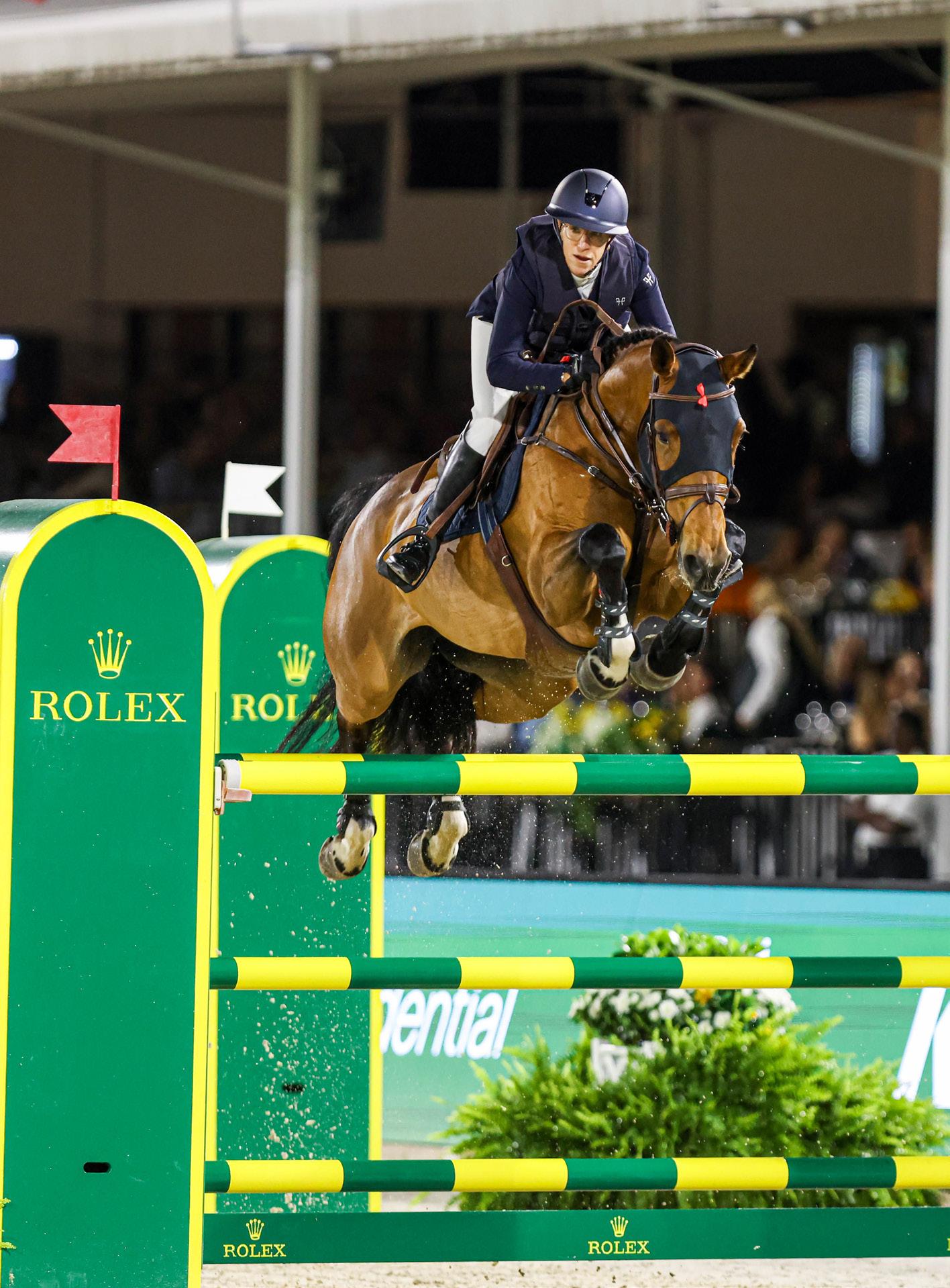


S.R. Blackinton, a sixth-generation silversmith based in Smithfield, R.I., has crafted the new trophy for the US Equestrian Open series. Founded in 2018, the family-run business continues a legacy that began in 1862 with Roswell Blackinton. His dedication to silversmithing has inspired generations, including Susanne Ross Blackinton-Juaire, who has been immersed in the craft since she was a teenager. S.R. Blackinton is famed for designing the trophy for the 150th anniversary of the Kentucky Derby.
The bespoke US Equestrian Open trophy is a stunning two-foot-tall three-sided tower, that showcases intricate horse and rider silhouettes representing the three Olympic disciplines of jumping, eventing, and dressage. Susanne, her daughter, Skyla, and their team worked tirelessly on the design, ensuring every detail reflects the artistry of equestrian sport. “We were excited to step away from traditional designs and create something unique,” Susanne said.
Set to debut at the Rolex US Equestrian Open Grand Prix on March 29, the trophy will also inspire a line of fine jewelry featuring silver and gold pendants of each of the three horses on the trophy, along with the US Equestrian signature horse. The BlackintonJuaires hope the trophy leaves a lasting impression on athletes, who will receive special keeper trophies featuring elements of the main design.




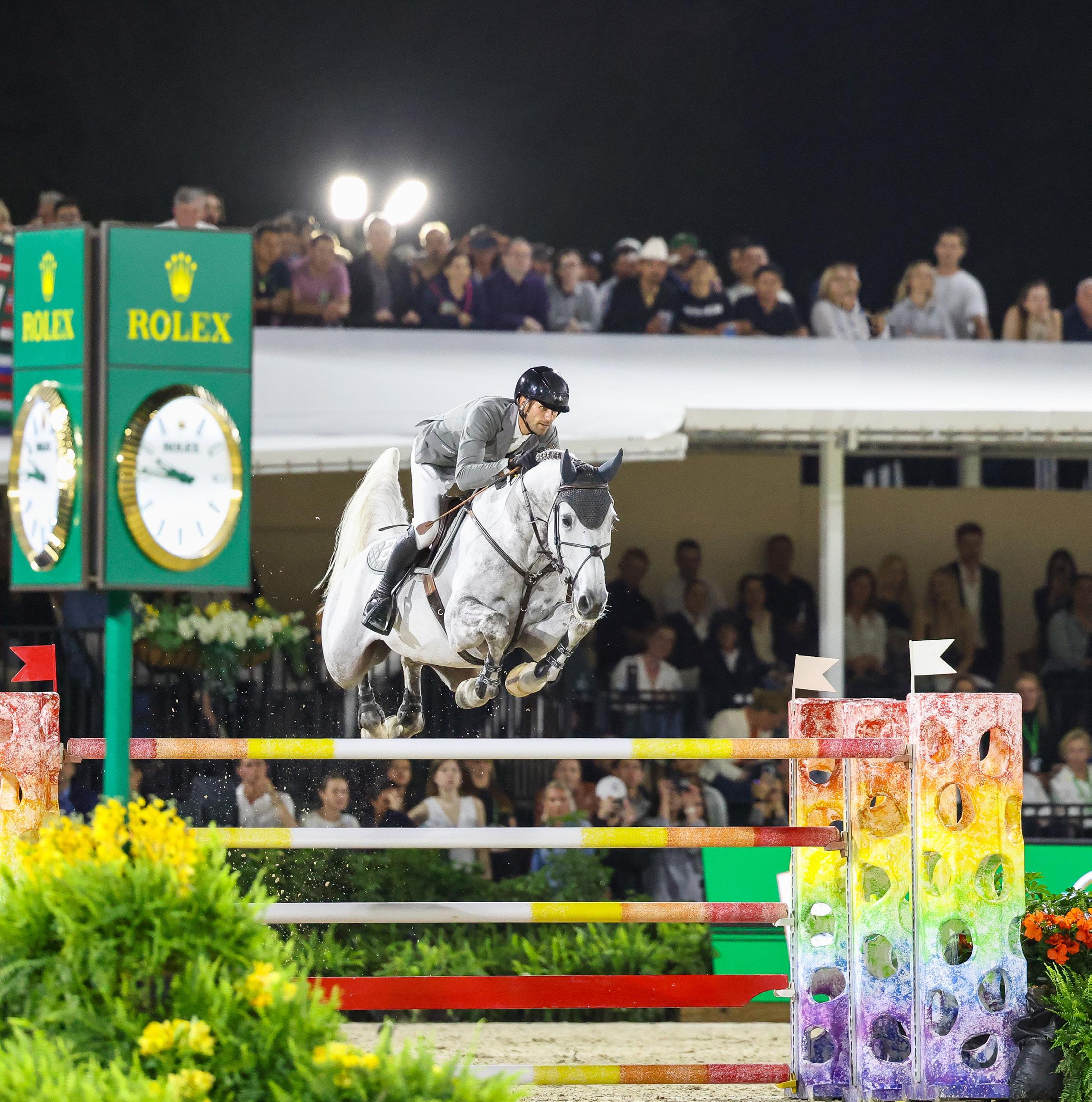


Whether to continue riding –and for how long – while pregnant is a very personal decision. Four riders share their stories on how they navigated pregnancy and their equestrian goals.
BY
HELEN TOWNES
Pregnancy and parenthood are guaranteed to transform a woman’s life. For equestrians, whether they are amateur or professional, the changes can be monumental. Pregnancy brings on new concerns about safety, and whether it will be physically possible — and for how long — to continue riding. For many, the thought of giving up riding for several months is daunting, as it may impact emotional wellbeing, competitive status and even livelihood.
Whether to ride or not during your pregnancy is very much an individual decision, said Dr. Mark Hart, USEF Human and Equine Safety & Welfare Committee Chair. “Riding during the first trimester is generally considered safe, as the uterus is well-protected within the pelvis,” he said. “There may be hormonal changes even early in the pregnancy, however, that can affect heart rate and breathing and even cause some ligament laxity.” Riders should not start a new discipline or do anything more demanding than normal during pregnancy, Dr. Hart said. Groundwork eliminates the risk of a fall, but safety while grooming or doing ground exercises is still important. “A kick to the abdomen or being knocked down if your horse spooks could pose a significant risk to the fetus,” Dr. Hart warned. Grand Prix jumper Alison Robitaille of Middleburg, Va., who has represented the U.S. at the FEI World Equestrian Games and in many FEI Jumping Nations Cups, was competing at a very high level when she got pregnant with her first daughter, Ava, who is now 15. “I had some trouble getting pregnant, so I was on fertility drugs. Because of that I was more focused on getting pregnant than on competing,” said Robitaille. She competed throughout the first trimester, including in FEI Jumping World Cup™ qualifiers, and continued doing flatwork at home until she was about five months pregnant. “But then I thought, ‘Why am I even doing this?’ knowing that I’d be due about the same
time as the World Finals,” Robitaille said. “It just didn’t feel that comfortable, so I stopped riding. I continued strength training to stay fit, and my training business was growing so I was busy teaching clients in the ring,” she added. With her second pregnancy (younger daughter Zoe is now 13), Robitaille stopped riding even sooner. “My belly was showing more quickly, and I just didn’t feel comfortable. I stopped competing before anyone knew I was pregnant,” she said.
Dressage rider Kasey Perry-Glass, who was on the bronze medal-winning U.S. team in 2016 at the Rio de Janeiro Summer Olympics, always knew she wanted to be a mom but planned her pregnancy with husband, Dana Glass, around her Danish Warmblood gelding Goerklintgaard’s Dublet’s retirement. “We got pregnant in just a couple of months, but I ended up having a miscarriage early on, and that took some time to process,” said Perry-Glass, who splits her time between Wellington, Fla., and Northern California. She became pregnant again a few months later but was surprised at how difficult the pregnancy was. “I thought I would love it, honestly. I couldn’t wait. But then, even though I was so grateful to be pregnant, I did not enjoy it at all. I was insanely tired and completely unmotivated,” she said.
Perry-Glass rode through her seventh month of pregnancy, despite her discomfort, because she had a very reliable horse who she knew well, but then she decided to back off. “I didn’t feel safe — I had a belly, and I just felt uneasy about it. Right around that time my blood pressure started to shoot up, and they were monitoring me for preeclampsia,” she explained. Perry-Glass’ daughter, Tru, was breech so she was born via caesarian section. While the pregnancy and birth were hard, fortunately, “everything afterward has gone smoothly,” she said.
Stephanie Danhakl, an adult amateur hunter rider based outside of Boston, Mass., also struggled with her first pregnancy, as well as stepping away from competitive riding. “In my 20s and early 30s, I was always more focused on training and competing than on having a family,” Danhakl said. “While I knew I would regret not having kids, it was hard to take time off from my horses.” However, when the COVID-19 pandemic hit and the show season slowed down, it seemed like the right time to start a family with husband, Peter. “When I was pregnant with my
“With horse life, you have early mornings and late nights, and with kids on top of that,” said Alison Robitaille, pictured on Oakingham's Lira at the 2023 Live Oak International.

son, I have to say I was very unhappy,” she said. “I didn’t like being pregnant at all, and I couldn’t wait to be back riding and competing. I had some health complications that required me to take a break from riding early on in the pregnancy. When I came back to ride again at four months pregnant, I felt my balance was compromised, so I stopped riding.”
With her daughter, Lydia, who is now one, Danhakl rode throughout most of her pregnancy and competed at Devon when she was six months pregnant. “I felt great during my second pregnancy. I rode and exercised almost every single day, so my balance was able to adjust to the changes happening to my body. I’ve been riding all my life, and I ride based on feel. I could always tell if my horse was too fresh, and I just wouldn’t ride that day,” she said.
Grand Prix jumper Molly Ashe-Cawley and her rider/trainer husband, Chris Cawley, waited until she was in her late 30s to start a family. Her first pregnancy went smoothly, and she was able to ride throughout most of it. “Taylor [her daughter, now 17] was so easy as far as riding while I was pregnant with her,” said Ashe-Cawley, who is based in Wellington, Fla., and also trains in Dover, Mass. “I showed in Europe all summer with her in my belly … I didn’t stop until my belly was hitting the pommel!” Her second pregnancy, with son Connor, now 15, was more difficult, however. “I didn’t feel as comfortable riding when I was pregnant with him, and I gained so much weight,” she said. “When you get pregnant, your body’s going to do what it’s going to do and there’s nothing you can really do about it.”
After giving birth, when to get back in the saddle differs greatly from mom to mom and is dependent on medical guidance. Women can generally expect to return to at least light riding within the first couple of weeks after natural childbirth, Dr. Hart said, while it’s recommended that those recovering from a caesarian birth generally should hold off for four to eight weeks before resuming their normal riding regimen.
Perry-Glass was back in the saddle eight weeks after Tru was born and was surprised at how good she felt. “I was going to get on and just walk, trot, do a little bit. But then I was cantering around, and my body just felt so good! It was like muscle memory for me,” she recalled. Perry-Glass returned to training clients and competing within a year of giving birth, and Tru has joined her at the barn since she was able to walk. “She’s a barn girl, and she loves it. She comes with me to the barn in the morning and cleans buckets, and does little things like that,” Perry-Glass said.
Robitaille returned to riding after four weeks with her first pregnancy. “The very first time I jumped a fence [after giving birth], I think I chipped and screamed a little, but it was funny more than anything,” she said. Robitaille waited longer after her second child, partly because she had several young horses that weren’t ready for competition — and because she had her hands full with a two-year-old toddler as well as a newborn baby. “It took a while to get back in the groove,” she explained.
The FEI offers guidelines on riding while pregnant, which includes the following warning signs on when to stop. The occurrence of any of these signs should be reported to your obstetrician.
• Excessive shortness of breath
• Chest pain or palpitations
• Fainting or dizziness
• Painful uterine contractions or preterm labor
• Leak of amniotic fluid
• Bleeding
• Excessive fatigue
• Abdominal pain
• Pelvic girdle pain
• Reduced fetal movement
• Breathlessness before exercise
• Headache
• Muscle weakness
• Calf pain or swelling
Kasey Perry-Glass and Mistico TM at the Global Dressage Festival in Wellington, Fla., the year before she became pregnant with daughter, Tru.
“MY BALANCE WAS ABLE TO ADJUST TO THE CHANGES HAPPENING TO MY BODY.”
– STEPHANIE DANHAKL
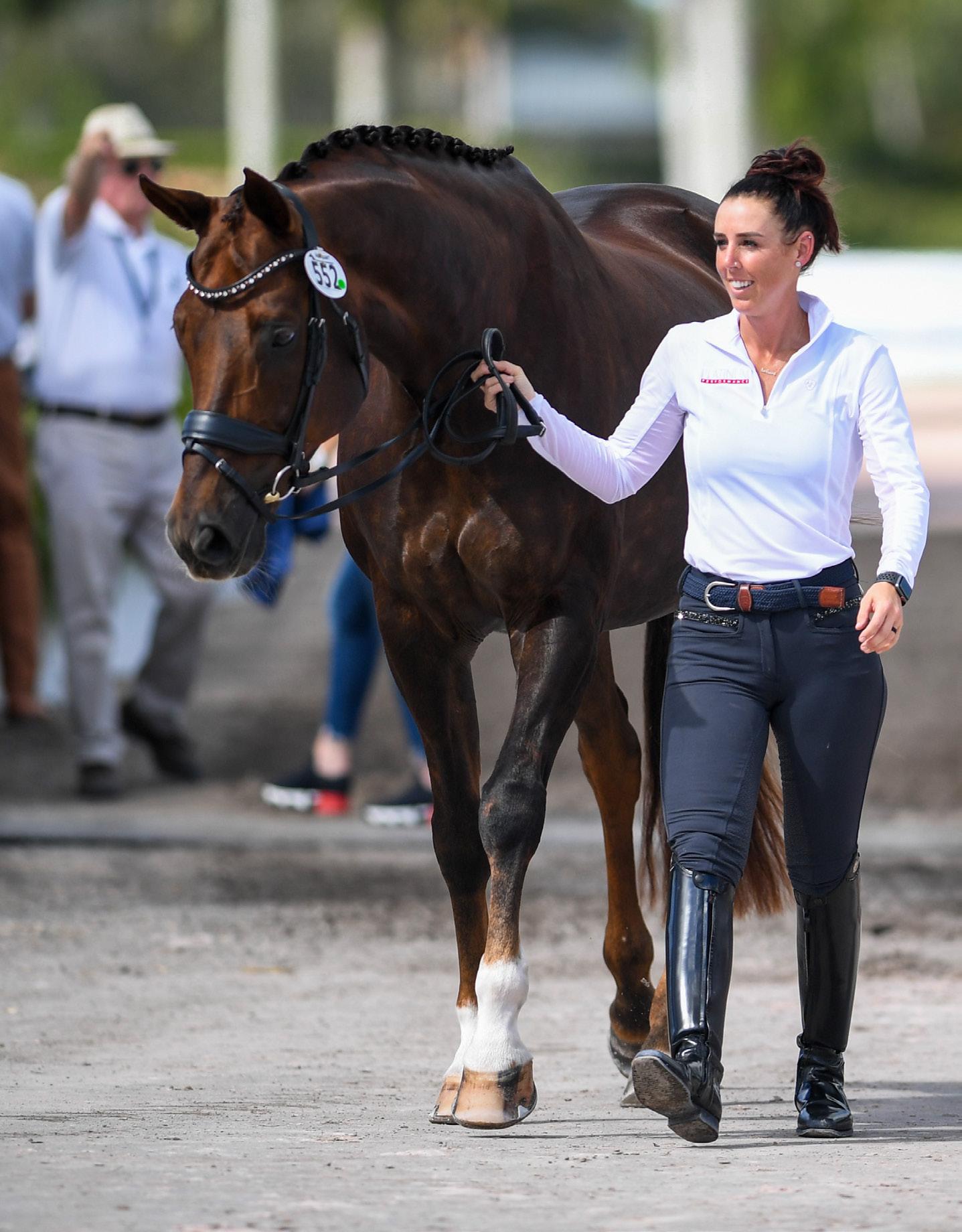
Kasey Perry-Glass on Goerklintgaards Dublet, her longtime mount whose retirement she planned her first pregnancy around.

“IT WAS HARD BALANCING HAVING A NEW BABY AND TRYING TO BE AT THE BARN.”
KASEY
Danhakl rode in the Washington International Horse Show seven weeks after her daughter, Lydia, was born. With her son Miles, now three, she took a little more time to come back to the saddle. “I didn’t feel as good physically after having Miles. It took two to three months for me to feel myself again on a horse.” Now she prioritizes bigger shows in the northeast that are closer to Massachusetts, and brings her children to Wellington, Fla., for six weeks in the winter so she can ride while also having quality family time.
Ashe-Cawley had planned caesarians for both of her children and was eager to get back in the saddle as soon as she recovered. “I rode six days after I had Taylor, and seven days after I had Connor,” she said. “And I was back in the show ring within four weeks or so, although I didn’t start with the Grand Prix competitions right away,” she recalled. However, she urges women to listen to their bodies, both during pregnancy and afterwards. “As a professional, the tendency is to keep going,” Ashe-Cawley said. “When I was pregnant with Taylor, I did everything I normally did, which was riding! But with Connor, I didn’t feel comfortable, and that was fine too. You have to trust your gut.”
Perry-Glass advises pregnant riders to “take your time in the baby stage. Looking back, I didn’t value it enough. It was hard balancing having a new baby and trying to be at the barn. I hope next time I can just relish it,” she said.
While mom-of-two Robitaille continues to compete internationally, she is realistic about the limits that pregnancy and parenthood place on competitive riders. “I don’t want to discourage anyone, but it’s probably more than you think it’s going to be. With horse life, you have early mornings and late nights, and with kids on top of that,” she said. “The biggest advice I’d give to other riders who are pregnant is to do what feels right for you.”
“As a professional, the tendency is to keep going,” said Molly Ashe-Cawley, pictured on Loukas De La Noue at the $100,000 Lugano 1.50m FEI 3* Grand Prix.
Looking back, Danhakl said she wouldn’t change anything she did during her pregnancies with Miles and Lydia, but she might take a little more time off if she and Peter have a third child. “The key is to always keep an open mind, and listen to yourself and your body,” she said. “I tend to push myself too hard and feel like I have to always do the most. Now that I have two kids, I am realizing that it’s OK to take it a little easy sometimes. It’s OK to not ride at all during pregnancy. It’s your choice. When my friends ask me for advice about when they should stop riding during pregnancy, I tell them that there is no right or wrong. I wouldn’t encourage anyone to ride while they were pregnant if they felt scared.
If you feel fearful and are trying to think of all the possible things that could go wrong, it’s no longer worth it or enjoyable at that point,” Danhakl stressed.
Riding well into pregnancy and after is possible, even at the elite level. However, the decision of when to curtail riding during pregnancy, and when to restart after giving birth, is an individual choice that should be made with your obstetric practitioner. “There are both benefits and risks to continuing to ride. First and foremost, it’s important to have close communication with your health provider throughout your pregnancy for their recommendations regarding your physical activities,” Dr. Hart said.


Monitoring a mare’s welfare during and after pregnancy is equally as important as that of her rider’s. Dr. Peyton Draheim, DVM, MS, DACT, an equine veterinarian at Hagyard Equine Medical Institute in Lexington, Ky., said that during the first four months of gestation, a pregnant mare can generally maintain her normal workload, including competing. However, in the first 30 days of pregnancy, it is crucial to avoid heat stress, as high heat and humidity have been linked to early embryonic loss before the heartbeat stage. Dr. Draheim advised that riders should avoid working a mare to the point of full sweating to minimize risk.
Aside from overheating, mares can continue the level of work they were comfortable with before breeding — including high-level disciplines — during the first few months of pregnancy, according to Dr. Draheim. “If she was doing Grand Prix jumping up until breeding and she’s still at that level, she’s fine to maintain that for three to four months as long as it doesn’t overheat her,” she said. “It is actually beneficial to have mares undergo exercise throughout gestation.”
However, once the mare reaches the four to five-month mark, her exercise routine should transition to lighter work. Dr. Draheim advised riders to closely monitor the
mare for signs of discomfort. “If she’s getting fatigued earlier in the ride, if she’s not collecting as well, not bending as well — certain cues like that guide you to tailoring her specific program,” Dr. Draheim said. For the final six weeks of pregnancy, however, Dr. Draheim recommends ceasing all riding and lunging. During this period, mares should still have turnout opportunities to move freely and maintain some level of physical activity without being pushed beyond their comfort zone.
Dr. Draheim outlines several red flags that riders should watch for while riding a pregnant mare. If a typically wellconditioned mare suddenly struggles with breathing, takes longer to recover after exercise, or shows unusual behavior such as refusing jumps or reacting negatively to bending exercises, these could be signs of discomfort or underlying issues. “Also, while you’re doing groundwork, see if she’s carrying herself differently, especially as the pregnancy progresses and she starts gaining the weight, because that alters her natural way of carrying of herself and her natural balance,” Dr. Draheim said.
“The other thing to keep in mind later into gestation, is her abdomen shape,” she continued. As her abdomen shape changes, it is important to make sure her tack fits properly
and watch for signs of pinching or pressure points. Dr. Draheim also advised against using spurs on pregnant mares and cautioned against making unnecessary tack adjustments unless the mare shows signs of discomfort.
If a mare displays signs of discomfort or a sudden change in temperament at any point in pregnancy, Dr. Draheim stressed the importance of contacting a veterinarian. Certain pregnancy-related conditions, such as a sudden increase in fluid volume within the placenta (hydrops), can cause symptoms like colic, reluctance to move, and difficulty breathing. Since these conditions can develop quickly, it is essential to monitor the mare’s behavior both in the field and under saddle. Any unusual signs, such as standing still for prolonged periods, reduced social interaction, or symptoms of colic or fever, should prompt a veterinary visit to ensure the health of both the mare and the foal.
After the foal is born, Dr. Draheim said that it is possible to begin light work with the mare before the foal is weaned, depending on the barn’s setup. “You can start working her sooner than weaning with the foal still on her side. The thing to keep in mind is that you don’t stress out mom or baby,” she said. If the facility has an enclosed indoor arena, the foal can be brought along to observe while the mare is exercised. Dr. Draheim recommended starting this process about a month after birth, allowing time for the mare to bond with her foal and establish her milk supply. It is important to acclimate the foal to the arena environment before resuming the mare’s training under saddle to minimize stress, and be sure to remove any objects such as mounting blocks, lunge whips, etc.
For those who wait until the foal is weaned before the mare returns to work, weaning typically occurs around five to six months postpartum. Dr. Draheim noted that resuming work at this point can be beneficial for the mare, giving her a new focus and aiding in her transition out of motherhood. Riders should begin with conditioning exercises and groundwork to gradually build the mare’s fitness before returning to more intense training. “She won’t snap right back into it. Some mares are faster than others, of course, but start with some groundwork, lunging and good conditioning work before asking her to really get back into a true training program,” said Dr. Draheim, who likened the process to rehabilitating a horse after stall rest, emphasizing the need for a gradual approach.
Dr. Draheim also highlighted the importance of monitoring the mare’s musculoskeletal health and hoof care as she returns to work. Pregnancy and nursing can cause changes in the mare’s body, and her feet may require different shoeing than before. “Remember to readdress her feet as you get ready to start putting her back into work,” Dr. Draheim said. Riders should ensure that the mare is moving comfortably and using her body correctly, paying close attention to any signs of lameness or discomfort. Ultimately, Dr. Draheim advised riders to listen to their mares, as they will often indicate when they are ready to resume work or if they need more time to recover. By taking a mindful and gradual approach to exercise during and after pregnancy, riders can help ensure the long-term health and well-being of their mare and foal.

Weaning typically occurs around five to six months after the foal is born, at which point it is safe for the mare to return to gentle work.
Arnie, the 2024 Heart Horse Award winner, is a former eventer & jumper who is now changing lives at Great Oak Assisted Programs in Aiken, S.C.
BY DEBBIE ELLIOT
Horses in all walks of life deserve to be celebrated, whether they are a hard-working trail horse, a loyal first pony, or an Olympic jumper. In 2024, US Equestrian created the Heart Horse Award, to honor the valuable work carried out by therapeutic horses in our Community Outreach Organizations. From helping an inner-city child through their first ride, to being a calming influence for those who need it most, these horses have each made an immeasurable difference to their communities.
“We honor horses at all levels of competition who are cherished and loved by their owners and fans. However, there are many horses that are not competing anymore, and there are organizations under the USEF that are recognized as Community Outreach Organizations that are using horses who have transitioned from competing to a non-competition life. We wanted to recognize the great horses in these programs because they do so much for people,”
USEF President Tom O’Mara said, when describing the inspiration behind the Heart Horse Award. The 2024 award was presented during the USEF Pegasus Awards Dinner on Thursday, January 23 in Lexington, Ky., as part of the 2025 US Equestrian Annual Meeting. “These are hero horses. They are not doing their original job, but they are doing a very dignified job.”
In order to decide on the recipient of the 2024 Heart Horse Award, USEF Community Outreach Organizations were invited to nominate horses that they thought were deserving of the award, the nominees were then narrowed down to four finalists that members voted on. “This is the first time we’re doing the Heart Horse Award,” O’Mara went on to say. “We are very proud that the Community Outreach Organizations are under our umbrella, and this is the perfect opportunity for us to recognize their horses for the great work they are doing for so many people, which might be going under the radar of our general membership.”
The winner of the inaugural Heart Horse Award found his way to Great Oak Assisted Programs in Aiken, S.C., via
a very unconventional route for a therapy horse. Kilcarna French Fancy, known to all as Arnie, came from a storied career as an eventer and jumper, having previously been ridden by Olympic gold medalist, Phillip Dutton, and Olympic and Pan Am Games team member Doug Payne. Arnie doesn’t look like a typical therapy horse either – at 17 hh, the 17-year-old Irish Sport Horse towers over his herd mates at Great Oak. However, what does make Arnie the perfect candidate for his latest career is his sensitivity, “I think he really understands the students who he works with, he has a connection with them,” said Great Oak barn manager Debbie McWhirter, who believes Arnie’s greatest asset is his empathy. “Arnie has just got the most incredible presence ... he’s the gentle giant,” agreed Great Oak program director Eva Finnan.
Arnie’s Road to Great Oak Assisted Programs
British eventer Laura Cocking originally bought Arnie as an unstarted youngster from Ireland and competed on him in the U.K. in 2013. “I think everyone had high hopes for this 17 hh Irish Sport Horse and thought he was going to be an amazing eventer and an amazing show jumper,” McWhirter explained. Arnie went on to be imported into the U.S. by Augie Vettorino, who later sent him to Dutton. In the spring of 2015, Dutton competed with Arnie at the Novice level, then moved him up to Training that summer. After campaigning Arnie, Dutton asked Matthew Ulmer to continue his training. Ulmer showed him but was convinced that eventing was not Arnie’s sport. Arnie then transitioned to the jumper ring and was shown by Payne after Vettorino introduced him to the horse.
“Arnie was a pretty tall, leggy horse. I thought of him as quite a rangy, athletic horse ... a good jumping horse,” recalled Payne, a member of the gold medal-winning eventing team at the 2019 Pan American Championships. “He was always super competitive. Having a willing, benevolent partner certainly makes your job a lot easier. That, paired with his athleticism, made him a formidable competitor for sure.”


Payne agreed that Arnie’s temperament also makes him a good candidate as a therapy horse. “I think the personality traits that would suit him well at a top level very well could translate to therapeutic riding,” he said. “There are certainly some [competition horses] that are kind of hard wired to be sharp, quick, and jumpy, and obviously that wouldn’t work. But in his case, he was always one that would try super hard to make it work and did it in a comfortable, soft way. For horses like that, I think it translates very well.”
Following his time with Payne, Arnie was acquired by Emily Smith, a young professional who competed with him at the Grand Prix level. “He was just a sweet horse,” she said. “But he was getting older, and it seemed he didn’t want to continue his jumping career.” Smith knew about Great Oak, and she thought Arnie might be a good fit. “I was really hopeful that it would work out,” she said. “I wanted to be sure he went somewhere he would be loved.”
When she was first approached about Arnie three years ago, Finnan asked herself, “‘Are we mad? How are we going to use a 17 hh horse in a therapeutic riding program? You have to find side walkers, and the students are going to be too intimidated,’” she said, but she was soon sold on the idea. “We went out and watched him and he had the most incredible presence. He had this really soft eye.”
Finnan and her colleagues simulated a therapeutic riding session with a side walker (someone who walks alongside the horse to physically and emotionally support the rider), and Arnie didn’t bat an eye. “Everything that we asked him to do, he did. He was just so very willing,” Finnan said. “We’d heard the stories about how he was being ridden by

the Olympians and how he was jumping, and they didn’t think he liked it ... he wasn’t enjoying what he was doing. I kept looking for signs of him saying he didn’t like this, like ‘get away from my right side,’ but he never did.”
Finnan initially started working with Arnie on the ground to get him used to the students, and vice versa, and said there was an instant connection. “It was really like one of these aha moments and I thought ‘he actually wants to really try this job.’”
Kerry Rains was a volunteer at Great Oak when Arnie made his grand arrival in 2022. “I remember thinking when he first arrived, ‘Oh my, he’s huge!’ We had talked about him, and I knew about his background as an eventer and jumper, but I don’t think I was quite prepared for his size,” she said. “I walked up to him, and he put his head down and greeted me. I took a deep breath, and he took a deep breath, what’s so remarkable about him is how easily he bonds with people. He just seemed really curious and interested in what we were doing and what we were asking him to do.”
“It still amazes me that he is with us considering his background. The fact that he worked at that caliber of eventing and jumping and is now able to have an unbalanced rider on his back,” Rains marveled. “Normally you would think a horse of that level would be too hot to be a therapy horse.”
Despite his success on the competition circuit, Finnan believes that Arnie has found his true calling. “He is so much happier in this job than when he was competing,

without a shadow of a doubt,” she said. “We do pole work to help the horses with their top line and Arnie looks at the poles and goes, ‘Wait a minute. Are you prepping me to start jumping?’ I just have to reassure him that I only want him to walk over them.”
Arnie quickly settled into his new life at Great Oak and, not surprisingly, became a favorite among the riders, staff, and volunteers. His adaptability means he can be used for students who need to walk or do upper body exercises because they are off balance, or he can be ridden by more advanced students who can walk, trot, and canter. “He’s very tolerant, forgiving, and kind, even when the riders make a mistake,” Finnan explained. “If they pull a little too hard on the mouth, he gently corrects them and brings his head back around and then just stops - it’s very endearing to watch. He’ll slightly adjust himself for each rider,” she added.
While the Irish Sport Horse’s impressive size is the first thing most people notice about him, it is his temperament that instills trust in all those who meet him. “People come in and they marvel over how tall he is, if he lifts his head up for any reason, he looks like a giraffe! But the students look right past that, I literally think that they look into his eyes, and they see his soul. He sees them, and they love him,” Finnan continued. “I think that he really does have a window through his eye to his soul. The students pick up on that.”
McWhirter agreed, saying “even the smallest kids aren’t afraid of him.” She describes Arnie as having “a very peaceful, calming, and caring nature ... he’s also a bit goofy and playful.”

“Everybody who comes here always wants to see the ‘big horse’ after lessons,” Rains said “They pet and scratch him and he loves it, he eats it up. He’s very happy.”
Arnie can still leg yield and do other moves from his dressage days, “he’s push button easy. He is very responsive to the leg and to the reins,” stated Rains. But more importantly is the confidence that he gives his riders, which passes over into other areas of their lives. “We have a rider named Kaleb Ross, who was non-verbal when he first came to us,” Rains said. “Then one day I was leading him around and I heard this voice, it was Kaleb who had finally gained enough confidence to speak. He’s really come a long way and absolutely adores Arnie. Some days he will ask if he can just hang out with Arnie. Kaleb talks to him and Arnie lowers his head and they breathe together. It’s like Arnie takes away all his problems.”
Rains describes working with Arnie as “leading around a feather pillow. You don’t really know that he’s there,” she said. “You start, he starts. You stop, he stops. He’s the epitome
Opposite: Arnie celebrates his award with the staff and students of Great Oak Assisted Programs
Inset: Arnie with professional rider Emily Smith, who arranged for him to join Great Oak Assisted Programs.
Left: Mette Larsen, President of Neue Schule USA, accepting the 2024 Heart Horse Award on behalf of Great Oak Assisted Programs from USEF President Tom O’Mara at the Pegasus Awards dinner.
Right: Arnie competing during his eventing career with Olympic gold medalist Phillip Dutton.

of what you want in a therapeutic riding horse and does everything perfectly.”
“We are lucky to have a horse like him and we are very thankful to Emily Smith for thinking of us as the last career for him,” McWhirter said.
While none of their pasts are quite as distinguished as Arnie’s, all of the horses at Great Oak had productive careers before landing in their current, and final, home. “All of these horses come to us for a reason,” McWhirter said. “It’s their second, third, or fourth careers ... it’s just wonderful to watch them flourish in this environment because not all horses are suited for it.” Seeing Arnie have that longevity of career instead of being retired to a pasture is especially rewarding to her. “He’s serving a purpose for us. I get great joy out of watching him. I think that he has found his true calling here at Great Oak as a therapy horse … this huge gentle giant who was trained to do big things has found his home here.”
Finnan agrees that being at Great Oak gives horses a soft landing in their later years. “They aren’t ready to just
go and retire. They still want to be given a job and asked to do things, and to be needed,” she said. “These horses give themselves to us wholeheartedly.”
Finnan said she hopes by reading Arnie’s story, it will encourage more people to think of new places for their competition horses after they retire from competing. “Unfortunately, I do think in the horse world that horses are still considered a commodity. When they are no longer doing the job that the human wants them to do, the humans can be quite callous and brutal,” she said. “Even if just a handful of people think, ‘I saw a horse who used to be a jumper and now has a job at a therapeutic riding center and he’s loving it,’ will plant the seed and show there is a step between a big career in the jumping and retirement,” Finnan continued.
For people who are looking for the next career for their horse, O’Mara recommends consulting US Equestrian’s directory of Community Outreach Organizations. “We have approved them already and they are legitimate organizations that have been vetted,” he said, therefore donors know the organizations will provide a safe place for their horse. Please visit youtube.com/watch?v=76JHbWtRQmU to watch a special video celebrating Arnie.
The other three finalists for the inaugural Heart Horse Award were:
BEAR A 28-year-old Haflinger at Special Equestrians in Warrington, Pa.
BUCK A 26-year-old Paint at Prancing Horse in Southern Pines, N.C.
TIGERLILY A 22-year-old Welsh Pony at Ride On in Los Angeles, Calif






Utilize the latest technology with T3 Matrix Saddle Pads for maximum comfort and freedom of moment

Contributed by the Regulation Department unless otherwise indicated. The following official notices are only intended to give penalty information for a given case and not to disclose the factual basis for each violation or penalty. For matters heard by the Hearing Committee, a Hearing Panel decides each case based on the evidence presented at the hearing and takes into account many factors that may raise or lower a given penalty. For example, the Hearing Committee takes into account such things as whether the violation was intentional or unintentional, the nature of the violation, the credibility of witnesses, Penalty Guidelines, penalties in similar cases, past violations of Federation rules by a respondent, and many other mitigating factors.
US Equestrian members can access and search the United States Equestrian Federation Suspension List online at USequestrian.org. Hover over the Compete tab on the homepage. In the menu that appears, click Ineligibility List under Rules, Regulations, and Grievances.
KELSEY WARE, of North Bennington, VT, as Trainer, violated Chapter 4, GR410 – GR411 of this Federation, in connection with the Saratoga Summer Horse Show held on August 14-18, 2024, in that the horse, CASANDRA, was exhibited after it had been administered and/or contained in its body cetirizine and hydroxyzine. The facts and mitigating factors in this case supported the following penalty even though it is below the suggested range for Category II Violations outlined in the Drugs and Medications Penalty Guidelines.
For this violation it was determined that KELSEY WARE be censured pursuant to Chapter 7, GR703.1a and fined $1,500 pursuant to Chapter 7, GR703.1j. It was further directed that for this violation of the rules, all trophies, prizes, ribbons, and monies, if any, won by CASANDRA at said competition must be redistributed pursuant to Chapter 7, GR703.1g.
KERRI LONG of Woodbine, MD, violated Chapter 4, GR410 of this Federation, in connection with the Loch Moy Summer Dressage Festival III Horse Show held on August 3, 2024, in that she, as Trainer, exhibited the horse, ROSSIGNOL, after it had been administered and/or contained in its body isoflupredone.
For this violation it was determined that pursuant to Chapter 7, GR703.1b and GR703.1f, KERRI LONG shall be found not in good standing, suspended from membership, and forbidden from the privilege of taking any part whatsoever in any Licensed Competition for one (1) month and excluded from all Competition grounds (cannot be on grounds from the time participants are admitted on the Competition grounds until the last time for departure). For example, suspended individuals may not be
on Competition grounds during schooling or other such days prior to the start of the Competition for any purpose, including such things as: coaching riders, training or schooling horses or trailering horses on or off Competition grounds) during Licensed Competitions for that period. Furthermore, suspended individuals are excluded from: (1) competition grounds as an exhibitor, participant or spectator; (2) from participating in all Federation affairs and activities, (3) from holding or exercising office in the Federation or in any Licensed Competition; and (4) from attending, observing or participating in any event, forum, meeting, program, clinic, task force, or committee of the Federation, sponsored by or conducted by the Federation, or held in connection with the Federation and any of its activities. Regulations as to suspended persons are set forth in detail in General Rule 704.
The one-month suspension shall commence on August 1, 2025, and terminate at midnight on August 31, 2025. Any horse or horses owned, leased, or of any partnership, corporation or stable of hers, or shown in her name or for her reputation, (whether such interest was held at the time of the alleged violation or acquired thereafter), shall also be suspended, pursuant to Chapter 7, GR703.1c for the same period.
KERRI LONG was also fined $2,000 pursuant to Chapter 7, GR703.1j. In connection with this penalty all trophies, prizes, ribbons, and monies, if any, won by ROSSIGNOL at said competition were redistributed pursuant to Chapter 7, GR703.1g.
NANCY WURTZ of Wells, ME, violated Chapter 4, GR410 of this Federation, in connection with The Atlanta Fall National
Horse Show held on October 5 – 6, 2024, in that she, as Trainer, exhibited the horse, RAAF C, after it had been administered and/or contained in its body 7-Carboxycannabidiol.
For this violation it was determined that pursuant to Chapter 7, GR703.1b and GR703.1f, NANCY WURTZ shall be found not in good standing, suspended from membership, and forbidden from the privilege of taking any part whatsoever in any Licensed Competition for two (2) months and excluded from all Competition grounds (cannot be on grounds from the time participants are admitted on the Competition grounds until the last time for departure). For example, suspended individuals may not be on Competition grounds during schooling or other such days prior to the start of the Competition for any purpose, including such things as: coaching riders, training or schooling horses or trailering horses on or off Competition grounds) during Licensed Competitions for that period. Furthermore, suspended individuals are excluded from: (1) competition grounds as an exhibitor, participant or spectator; (2) from participating in all Federation affairs and activities, (3) from holding or exercising office in the Federation or in any Licensed Competition; and (4) from attending, observing or participating in any event, forum, meeting, program, clinic, task force, or committee of the Federation, sponsored by or conducted by the Federation, or held in connection with the Federation and any of its activities. Regulations as to suspended persons are set forth in detail in General Rule 704.
The two-month suspension shall commence on September 1, 2025, and terminate at midnight on October 31, 2025. Any horse or
horses owned, leased, or of any partnership, corporation or stable of hers, or shown in her name or for her reputation, (whether such interest was held at the time of the alleged violation or acquired thereafter), shall also be suspended, pursuant to Chapter 7, GR703.1c for the same period.
NANCY WURTZ was also fined $3,000 pursuant to Chapter 7, GR703.1j. In connection with this penalty all trophies, prizes, ribbons, and monies, if any, won by RAAF C at said competition were redistributed pursuant to Chapter 7, GR703.1g.
MAX AMAYA of Freehold, NJ, as Trainer, violated Chapter 4, GR410 of this Federation, in connection with the Fieldstone Show Park North East Classic Horse Show held on September 4-8, 2024, in that the horse, JUST SPECIAL, was exhibited after it had been administered and/or contained in its body methocarbamol in a plasma concentration exceeding the maximum permitted level.
For this violation it was determined that MAX AMAYA be censured pursuant to Chapter 7, GR703.1a and fined $1,000 pursuant to Chapter 7, GR703.1k. It was further directed that for this violation of the rules, all trophies, prizes, ribbons, and monies, if any, won by JUST SPECIAL, at said competition must be redistributed pursuant to Chapter 7, GR703.1g.
HALLIEA MILNER of Canton, GA, violated Chapter 4, GR410 of this Federation, in connection with the River Glen Summer Horse Trials Horse Show held on August 2-4, 2024, in that she, as Trainer, exhibited the horse, L’AVVENTURA, after it had been administered and/or contained in its body flunixin and dexamethasone in plasma concentrations exceeding the maximum permitted levels.
For this violation it was determined that pursuant to Chapter 7, GR703.1b and GR703.1f, HALLIEA MILNER shall be found not in good standing, suspended from membership, and forbidden from the privilege of taking any part whatsoever in any Licensed Competition for two (2) months and excluded from all Competition grounds (cannot be on grounds from the time participants are admitted on the Competition grounds until the last time for departure). For example, suspended individuals may not be on Competition grounds during schooling or other such days prior to the start of the Competition for any purpose, including such things as: coaching riders, training or schooling horses or trailering horses on or off Competition grounds) during Licensed Competitions for that period. Furthermore, suspended individuals are excluded from: (1) competition grounds as an exhibitor, participant or spectator; (2) from participating in all Federation affairs and activities, (3) from holding or exercising office in the Federation or in any Licensed Competition; and (4) from attending, observing or participating in any event,
forum, meeting, program, clinic, task force, or committee of the Federation, sponsored by or conducted by the Federation, or held in connection with the Federation and any of its activities. Regulations as to suspended persons are set forth in detail in General Rule 704.
The two-month suspension shall commence on July 1, 2025, and terminate at midnight on August 31, 2025. Any horse or horses owned, leased, or of any partnership, corporation or stable of hers, or shown in her name or for her reputation, (whether such interest was held at the time of the alleged violation or acquired thereafter), shall also be suspended, pursuant to Chapter 7, GR703.1c for the same period.
HALLIEA MILNER was also fined $3,500 pursuant to Chapter 7, GR703.1j. In connection with this penalty all trophies, prizes, ribbons, and monies, if any, won by L’AVVENTURA at said competition were redistributed pursuant to Chapter 7, GR703.1g.
DAVID HYSAW of Johnston, IA, violated Chapter 4, GR410 of this Federation, in connection with the St. Louis National Charity Horse Show held on
September 25 – 28, 2024, in that he, as Trainer, exhibited the horse, REEDANN’S MEANT TO BE, after it had been administered and/or contained in its body acepromazine and 2(1-hydroxyethyl) promazine sulfoxide.
For this violation it was determined that pursuant to Chapter 7, GR703.1b and GR703.1f, DAVID HYSAW shall be found not in good standing, suspended from membership, and forbidden from the privilege of taking any part whatsoever in any Licensed Competition for two (2) months and excluded from all Competition grounds (cannot be on grounds from the time participants are admitted on the Competition grounds until the last time for departure). For example, suspended individuals may not be on Competition grounds during schooling or other such days prior to the start of the Competition for any purpose, including such things as: coaching riders, training or schooling horses or trailering horses on or off Competition grounds) during Licensed Competitions for that period. Furthermore, suspended individuals are excluded from: (1) competition grounds as an exhibitor, participant or
spectator; (2) from participating in all Federation affairs and activities, (3) from holding or exercising office in the Federation or in any Licensed Competition; and (4) from attending, observing or participating in any event, forum, meeting, program, clinic, task force, or committee of the Federation, sponsored by or conducted by the Federation, or held in connection with the Federation and any of its activities. Regulations as to suspended persons are set forth in detail in General Rule 704.
The two-month suspension shall commence on August 1, 2025, and terminate at midnight September 30, 2025. Any horse or horses owned, leased, or of any partnership, corporation or stable of his, or shown in his name or for his reputation, (whether such interest was held at the time of the alleged violation or acquired thereafter), shall also be suspended, pursuant to Chapter 7, GR703.1c for the same period.
DAVID HYSAW was also fined $3,000 pursuant to Chapter 7, GR703.1j. In connection with this penalty all trophies, prizes, ribbons, and monies, if any, won by REEDANN’S MEANT TO BE



at said competition were redistributed pursuant to Chapter 7, GR703.1g.
THAMARA ENRIQUEZ of Miami, FL, violated Chapter 4, GR410 of this Federation, in connection with the WEC Ocala Summer #2 Horse Show held on June 18 – 23, 2024, in that he, as Trainer, exhibited the horse, O-CENTURIO VAN STAL CIPA, after it had been administered and/or contained in its body 3-Carboxydetomidine.
For this violation it was determined that pursuant to Chapter 7, GR703.1b and GR703.1f, THAMARA ENRIQUEZ shall be found not in good standing, suspended from membership, and forbidden from the privilege of taking any part whatsoever in any Licensed Competition for two (2) months and excluded from all Competition grounds (cannot be on grounds from the time participants are admitted on the Competition grounds until the last time for departure). For example, suspended individuals may not be on Competition grounds during schooling or other such days prior to the start of the Competition for any purpose, including such things as: coaching riders, training or schooling horses or trailering horses on or off Competition grounds) during Licensed Competitions for that period. Furthermore, suspended individuals are excluded from: (1) competition grounds as an exhibitor, participant or spectator; (2) from participating in all Federation affairs and activities, (3) from holding or exercising office in the Federation or in any Licensed Competition; and (4) from attending, observing or participating in any event, forum, meeting, program, clinic, task force, or committee of the Federation, sponsored by or conducted by the Federation, or held in connection with the Federation and any of its activities. Regulations as to suspended persons are set forth in detail in General Rule 704.
The two-month suspension shall commence on May 1, 2025, and terminate at midnight on June 30, 2025. Any horse or horses owned, leased, or of any partnership, corporation or stable of his, or shown in his name or for his reputation, (whether such interest was held at the time of the alleged violation or acquired thereafter), shall also be suspended, pursuant to Chapter 7, GR703.1c for the same period.
THAMARA ENRIQUEZ was also fined $3,000 pursuant to Chapter 7, GR703.1j. In connection
with this penalty all trophies, prizes, ribbons, and monies, if any, won by O-CENTURIO VAN STAL CIPA at said competition were redistributed pursuant to Chapter 7, GR703.1g.
KOLBY SMITH of Waynesburg, PA, violated Chapter 4, GR410 and GR414 of this Federation, in connection with the St. Louis National Charity Horse Show held on September 25-28, 2024, in that she, as Trainer, exhibited the horse, TEMPERAMENTAL, after it had been administered and/or contained in its body flunixin in a plasma concentration exceeding the maximum permitted level which was administered within 12-hours of competition.
For this violation it was determined that pursuant to Chapter 7, GR703.1b and GR703.1f, KOLBY SMITH shall be found not in good standing, suspended from membership, and forbidden from the privilege of taking any part whatsoever in any Licensed Competition for one month and excluded from all Competition grounds (cannot be on grounds from the time participants are admitted on the Competition grounds until the last time for departure). For example, suspended individuals may not be on Competition grounds during schooling or other such days prior to the start of the Competition for any purpose, including such things as: coaching riders, training or schooling horses or trailering horses on or off Competition grounds) during Licensed Competitions for that period. Furthermore, suspended individuals are excluded from: (1) competition grounds as an exhibitor, participant or spectator; (2) from participating in all Federation affairs and activities, (3) from holding or exercising office in the Federation or in any Licensed Competition; and (4) from attending, observing or participating in any event, forum, meeting, program, clinic, task force, or committee of the Federation, sponsored by or conducted by the Federation, or held in connection with the Federation and any of its activities. Regulations as to suspended persons are set forth in detail in General Rule 704.
The one-month suspension shall commence on September 1, 2025, and terminate at midnight on September 30, 2025. Any horse or horses owned, leased, or of any partnership, corporation or stable of hers, or shown in her name or for her reputation, (whether such interest was held at the time of the alleged
violation or acquired thereafter), shall also be suspended, pursuant to Chapter 7, GR703.1c for the same period.
KOLBY SMITH was also fined $2,500 pursuant to Chapter 7, GR703.1j. In connection with this penalty all trophies, prizes, ribbons, and monies, if any, won by TEMPERAMENTAL at said competition were redistributed pursuant to Chapter 7, GR703.1g.
LISA PERRI, of Malvern, PA, violated Chapter 4, GR410 and GR414.1, of this Federation, in connection with the Mid Atlantic Autumn Classic Horse Show held October 31 – November 3, 2024, in that she, as Trainer, exhibited the horse, STONEHENGE, after it had been administered and/or contained in its body acepromazine and 2(1-hydroxyethyl) promazine sulfoxide, and the administration was within 12 hours of competition.
For these violations it was determined that pursuant to Chapter 7, GR703.1b and GR703.1f, LISA PERRI shall be found not in good standing, suspended from membership, and forbidden from the privilege of taking any part whatsoever in any Licensed Competition for three (3) months and is excluded from all Competition grounds (cannot be on grounds from the time participants are admitted on the Competition grounds until the last time for departure). For example, suspended individuals may not be on Competition grounds during schooling or other such days prior to the start of the Competition for any purpose, including such things as: coaching riders, training or schooling horses, or trailering horses on or off Competition grounds during Licensed Competitions for that period. Furthermore, suspended individuals are excluded from: competition grounds as (1) an exhibitor, participant or spectator; (2) from participating in all Federation affairs and activities; (3)from holding or exercising office in the Federation or in any Licensed Competition; and (4)from attending, observing, or participating in any event, forum, meeting, program, clinic, task force, or committee of the Federation, sponsored by or conducted by the Federation, or held in connection with the Federation and any of its activities. Regulations as to suspended persons are set forth in detail in General Rule 704.
The three-month suspension shall commence on September 1, 2025, and terminate at midnight
on November 30, 2025. Any horse or horses owned, leased, or of any partnership, corporation or stable of hers, or shown in her name or for her reputation (whether such interest was held at the time of the alleged violation or acquired thereafter), shall also be suspended, pursuant to Chapter 7, GR703.1c, for the same period.
LISA PERRI was also fined $4,000, pursuant to Chapter 7, GR703.1j. In connection with this penalty all trophies, prizes, ribbons, and monies, if any, won by STONEHENGE at said competition were redistributed pursuant to Chapter 7, GR703.1g.
BRET DAY, of Versailles, KY, violated Chapter 4, GR410, of this Federation, in connection with All American Horse Classic Horse Show held September 10 - 14, 2024, in that he, as Trainer, exhibited the horse, MARINE HEIR, after it had been administered and/or contained in its body detomidine, 3-carboxydetomidine, and 3-hydroxydetomidine.
For this violation it was determined that pursuant to Chapter 7, GR703.1b and GR703.1f, BRET DAY shall be found not in good standing, suspended from membership, and forbidden from the privilege of taking any part whatsoever in any Licensed Competition for one (1) month and is excluded from all Competition grounds (cannot be on grounds from the time participants are admitted on the Competition grounds until the last time for departure). For example, suspended individuals may not be on Competition grounds during schooling or other such days prior to the start of the Competition for any purpose, including such things as: coaching riders, training or schooling horses, or trailering horses on or off Competition grounds during Licensed Competitions for that period. Furthermore, suspended individuals are excluded from: competition grounds as (1) an exhibitor, participant or spectator; (2) from participating in all Federation affairs and activities; (3)from holding or exercising office in the Federation or in any Licensed Competition; and (4)from attending, observing, or participating in any event, forum, meeting, program, clinic, task force, or committee of the Federation, sponsored by or conducted by the Federation, or held in connection with the Federation and any of its activities. Regulations as to suspended persons are set forth in detail in General Rule 704.
The one-month suspension shall commence on September 1, 2025, and terminate at midnight on September 30, 2025. Any horse or horses owned, leased, or of any partnership, corporation or stable of his, or shown in his name or for his reputation (whether such interest was held at the time of the alleged violation or acquired thereafter), shall also be suspended, pursuant to Chapter 7, GR703.1c, for the same period.
BRET DAY was also fined $3,000, pursuant to Chapter 7, GR703.1j. In connection with this penalty all trophies, prizes, ribbons, and monies, if any, won by MARINE HEIR at said competition were redistributed pursuant to Chapter 7, GR703.1g.
KIMBERLY EGAN of Woodbine, MD, violated Chapter 4, GR410 of this Federation, in connection with The Maryland Horse Trials at Loch Moy Farm held on October 4 - 6, 2024, in that she, as Trainer, exhibited the horse, HIGH STREET, after it had been administered and/or contained in its body medroxyprogesterone acetate.
For this violation it was determined that pursuant to Chapter 7, GR703.1b and GR703.1f, KIMBERLY EGAN shall be found not in good standing, suspended from membership, and forbidden from the privilege of taking any part whatsoever in any Licensed Competition for three (3) months and excluded from all Competition grounds (cannot be on grounds from the time participants are admitted on the Competition grounds until the last time for departure). For example, suspended individuals may not be on Competition grounds during schooling or other such days prior to the start of the Competition for any purpose, including such things as: coaching riders, training or schooling horses or trailering horses on or off Competition grounds) during Licensed Competitions for that period. Furthermore, suspended individuals are excluded from: (1) competition grounds as an exhibitor, participant or spectator; (2) from participating in all Federation affairs and activities, (3) from holding or exercising office in the Federation or in any Licensed Competition; and (4) from attending, observing or participating in any event, forum, meeting, program, clinic, task force, or committee of the Federation, sponsored by or conducted by the Federation, or held in connection with the Federation and any of its activities. Regulations as to suspended persons are set forth in detail in General Rule 704.
The three-month suspension shall commence on September 1,
2025, and terminate at midnight on November 30, 2025. Any horse or horses owned, leased, or of any partnership, corporation or stable of hers, or shown in her name or for her reputation, (whether such interest was held at the time of the alleged violation or acquired thereafter), shall also be suspended, pursuant to Chapter 7, GR703.1c for the same period.
KIMBERLY EGAN was also fined $3,000 pursuant to Chapter 7, GR703.1j. In connection with this penalty all trophies, prizes, ribbons, and monies, if any, won by HIGH STREET at said competition were redistributed pursuant to Chapter 7, GR703.1g.
ROBERT WISE of Yucaipa, CA, violated Chapter 7, GR702.1.a, GR702.1.d, and GR702.1.f; Chapter 8, GR838.2, GR838.4.a, GR838.4.b, GR838.4.k, and GR838.4.m; of this Federation and the USEF Code of Conduct, in connection with the Region 7 Arabian Championship Horse Show held April 29 – May 5, 2024, in Scottsdale, AZ, in that on or about May 1, 2024, he was driving a carriage horse, RS BIG BANG THEORY, in an aggressive and dangerous manner, by overusing his whip on the horse and aggressively using the reins. His conduct endangered not just the horse, but other participants and horses on competition grounds. Further, following the driving incident, Mr. Wise admitted to directing the horse to be tied in the stall as a form of punishment to the horse.
The Federation resolved this matter through an informal resolution with Mr. Wise following a thorough investigation. In determining the proper penalty, the Federation took into account the facts and circumstances of this matter as well as the seriousness of the violations and determined that the following penalties were appropriate.
For his violations of the Rules, and pursuant to General Rule 703.1.b and General Rule 703.1.f, ROBERT WISE shall be found not in good standing, suspended from membership, and forbidden from the privilege of taking any part whatsoever in any Licensed Competition for one (1) month and is excluded from all competition grounds (cannot be on grounds from the time participants are admitted on the competition grounds until the last time for departure). For example, suspended individuals may not be on competition grounds during schooling or other such days prior to the start of the




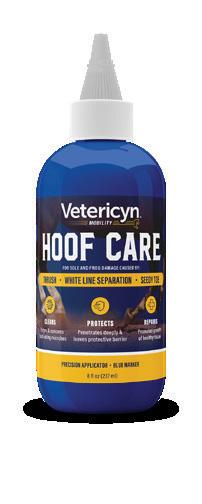


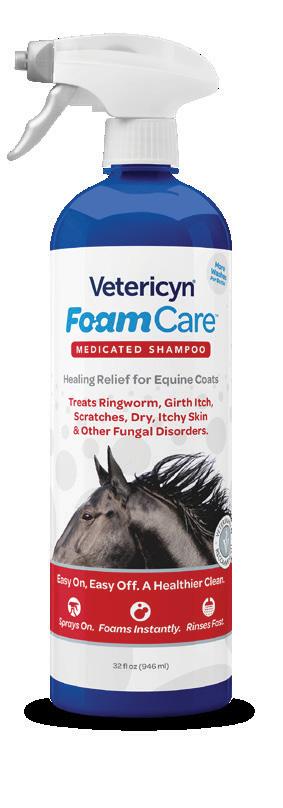

Vetericyn® makes the most advanced, effective, and safe products to keep horses healthy. Whether it’s cleaning wounds, treating hoof or eye issues, or conditioning and cleaning the coat, horse lovers trust Vetericyn for total equine wellness.
competition for any purpose, including such things as: coaching riders, training or schooling horses, or trailering horses on or off competition grounds during Licensed Competitions for that period. Furthermore, suspended individuals are excluded from: (1) competition grounds as an exhibitor, participant, or spectator; (2) from participating in all Federation affairs and activities; (3) from holding or exercising office in the Federation or in any Licensed Competition; and (4) from attending, observing, or participating in any event, forum, meeting, program, clinic, task force, or committee of the Federation, sponsored by or conducted by the Federation, or held in connection with the Federation and any of its activities.
The one-month suspension shall commence on April 1, 2025, and terminate at midnight on April 30, 2025. Any horse or horses, completely or in part owned, leased, or of any partnership, corporation or stable of his, or shown in his name or for his reputation (whether such interest was held at the time of the alleged violation or acquired thereafter), shall also be suspended pursuant to General Rule 703.1.c for the same time period.
It was further directed that ROBERT WISE be fined in the amount of $2,500, pursuant to General Rule 703.1.k.
DARLENE BENTLY of Yucaipa, CA, violated Chapter 7, GR702.1.a, GR702.1.d, and GR702.1.f; Chapter 8, GR838.2, GR838.4.a, GR838.4.b, GR838.4.k, and GR838.4.m; of this Federation, and the USEF Code of Conduct, in connection with the Region 7 Arabian Championship Horse Show held April 29 – May 5, 2024, in Scottsdale, AZ, in that on or about May 1, 2024, she knowingly allowed Robert Wise to drive her carriage horse, RS BIG BANG THEORY, in an aggressive and dangerous manner, by overusing his whip on the horse and aggressively using the reins. Mr. Wise’s conduct endangered not just the horse, but other participants and horses on competition grounds. Further, following the driving incident, Mr. Wise admitted to directing the horse to be tied in the stall as a form of punishment to the horse.
The Federation resolved this matter through an informal resolution with Ms. Bently following a thorough investigation. In determining the proper penalty, the Federation took into account the facts and circumstances as well as the seriousness of the violations
and determined that the following penalties were appropriate.
For her violations of the Rules, it was determined that DARLENE BENTLY be fined in the amount of $1,500, pursuant to General Rule 703.1.k.
SUSAN ALLEN, of Cocoa, FL, violated Chapter 4, GR410, of this Federation, in connection with the WEC Ocala December #1 Horse Show held December 3 - 8, 2024, in that she, as Trainer, exhibited the horse, KENNEDY, after it had been administered and/or contained in its body acepromazine and 2(1-hydroxyethyl) promazine sulfoxide.
For this violation it was determined that pursuant to Chapter 7, GR703.1b and GR703.1f, SUSAN ALLEN shall be found not in good standing, suspended from membership, and forbidden from the privilege of taking any part whatsoever in any Licensed Competition for two (2) months and is excluded from all Competition grounds (cannot be on grounds from the time participants are admitted on the Competition grounds until the last time for departure). For example, suspended individuals may not be on Competition grounds during schooling or other such days prior to the start of the Competition for any purpose, including such things as: coaching riders, training or schooling horses, or trailering horses on or off Competition grounds during Licensed Competitions for that period. Furthermore, suspended individuals are excluded from: competition grounds as (1) an exhibitor, participant or spectator; (2) from participating in all Federation affairs and activities; (3) from holding or exercising office in the Federation or in any Licensed Competition; and (4) from attending, observing, or participating in any event, forum, meeting, program, clinic, task force, or committee of the Federation, sponsored by or conducted by the Federation, or held in connection with the Federation and any of its activities. Regulations as to suspended persons are set forth in detail in General Rule 704.
The two-month suspension shall commence on November 1, 2025, and terminate at midnight on December 31, 2025. Any horse or horses owned, leased, or of any partnership, corporation or stable of hers, or shown in her name or for her reputation (whether such interest was held at the time of the alleged violation or acquired thereafter), shall also be suspended, pursuant to
Chapter 7, GR703.1c, for the same period.
SUSAN ALLEN was also fined $3,000, pursuant to Chapter 7, GR703.1j. In connection with this penalty all trophies, prizes, ribbons, and monies, if any, won by KENNEDY at said competition were redistributed pursuant to Chapter 7, GR703.1g.
CARL CANTINI of N Marshfield, MA, violated Chapter 4, GR410 of this Federation, in connection with the Head of the Bay Classic I Horse Show held July 24 – 28, 2024 and the New England Equitation Championships, Inc. Horse Show held on October 16 – 20, 2024, in that he, as Trainer, exhibited the horse, CHELLO Z, at both competitions after it had been administered and/or contained in its body 7-Carboxycannabidiol. The facts and mitigating factors in this case supported the following penalty even though it is below the suggested range for Category III Violations outlined in the Drugs and Medications Penalty Guidelines. Further, these violations were combined for purposes of the below penalties.
For these violations it was determined that pursuant to Chapter 7, GR703.1b and GR703.1f, CARL CANTINI shall be found not in good standing, suspended from membership, and forbidden from the privilege of taking any part whatsoever in any Licensed Competition for two (2) months and is excluded from all Competition grounds (cannot be on grounds from the time participants are admitted on the Competition grounds until the last time for departure). For example, suspended individuals may not be on Competition grounds during schooling or other such days prior to the start of the Competition for any purpose, including such things as: coaching riders, training or schooling horses, or trailering horses on or off Competition grounds during Licensed Competitions for that period. Furthermore, suspended individuals are excluded from: competition grounds as (1) an exhibitor, participant or spectator; (2) from participating in all Federation affairs and activities; (3) from holding or exercising office in the Federation or in any Licensed Competition; and (4) from attending, observing, or participating in any event, forum, meeting, program, clinic, task force, or committee of the Federation, sponsored by or conducted by the Federation, or held in connection with the
Federation and any of its activities. Regulations as to suspended persons are set forth in detail in General Rule 704.
The two-month suspension shall commence on June 1, 2025, and terminate at midnight on July 31, 2025. Any horse or horses owned, leased, or of any partnership, corporation or stable of his, or shown in his name or for his reputation (whether such interest was held at the time of the alleged violation or acquired thereafter), shall also be suspended, pursuant to Chapter 7, GR703.1c, for the same period.
CARL CANTINI was also fined $3,000, pursuant to Chapter 7, GR703.1j. In connection with this penalty all trophies, prizes, ribbons, and monies, if any, won by CHELLO Z at said competition were redistributed pursuant to Chapter 7, GR703.1g.
ELEANOR KUNSMAN , of Chester, NJ, violated Chapter 7, GR702.1.a, GR702.1.d, and GR702.1.f; Chapter 8, GR838.4.b, GR838.4.c, GR838.4.m, and GR838.5; JP102.2; of this Federation, and the USEF Code of Conduct, in connection with the Hampton Classic Horse Show held August 25 – September 1, 2024, in Bridgehampton, NY, in that on or about August 28, 2024, she intentionally and deliberately, on multiple occasions, kicked with her spur the horse, FIBONACCI S, on its front leg coronet/pastern. Her actions towards the horse were deemed to be detrimental and/or prejudicial to the best interests and reputation of USEF and the sport of equestrian.
The Federation resolved this matter through an informal resolution with Ms. Kunsman following a thorough investigation, to which Ms. Kunsman fully cooperated with the Federation. In determining the proper penalty, the Federation took into account the seriousness of the violations and determined that the following penalties were appropriate.
For her violations of the Rules, it was determined that ELEANOR KUNSMAN shall be censured, pursuant to General Rule GR703.1.a, and fined in the amount of $2,000, pursuant to General Rule 703.1.k.
DAVID BUSTILLOS, of Aliso Viejo, CA, violated Chapter 7, GR702.1.a, GR702.1.d, and GR702.1.f; Chapter 8, GR838.4.b and GR838.4.m; of this Federation and the USEF Code of Conduct, in connection with the Summer In The Rockies 1 Horse Show held June 12-16, 2024, in Parker, CO, in that on or about June 16, 2024, his actions towards the horse,
BORDEAUX, were deemed to be detrimental and/or prejudicial to the image and reputation of USEF and the sport of equestrian, when he failed to place the wellbeing and safety of the horse above all other considerations.
Specifically, Mr. Bustillos was witnessed long lining, ground driving, and working the horse, BORDEAUX, in circles with its head tied down such that when the horse reared, it was unable to extend its neck and fell on its side. After the horse stood up, Mr. Bustillos continued working the horse, showing no concern for the horse’s well-being and confirming that the horse had not been injured during the fall. Furthermore, he was working the horse with a contraption over the horse’s poll that contained a twisted wire.
The Federation resolved this matter through an informal resolution with Mr. Bustillos following a thorough investigation, to which Mr. Bustillos fully cooperated with the Federation. In determining the proper penalty, the Federation took into account the seriousness of the violations and determined that the following penalties were appropriate.
For his violations it was determined that pursuant to General Rule 703.1.b and General Rule 703.1.f, DAVID BUSTILLOS shall be found not in good standing, suspended from membership, and forbidden from the privilege of taking any part whatsoever in any Licensed Competition for one (1) month and is excluded from all competition grounds (cannot be on grounds from the time participants are admitted on the competition grounds until the last time for departure). For example, suspended individuals may not be on competition grounds during schooling or other such days prior to the start of the competition for any purpose, including such things as: coaching riders, training or schooling horses, or trailering horses on or off competition grounds during Licensed Competitions for that period. Furthermore, suspended individuals are excluded from: (1) competition grounds as an exhibitor, participant, or spectator; (2) from participating in all Federation affairs and activities; (3) from holding or exercising office in the Federation or in any Licensed Competition; and (4) from attending, observing, or participating in any event, forum, meeting, program, clinic, task force, or committee of the Federation, sponsored by or conducted by the Federation, or held in connection with the Federation and any of its activities.
The one-month suspension shall commence on June 1, 2025, and terminate at midnight on June 30, 2025. Any horse or horses, completely or in part owned, leased, or of any partnership, corporation or stable of his, or shown in his name or for his reputation (whether such interest was held at the time of the alleged violation or acquired thereafter), shall also be suspended pursuant to General Rule 703.1.c for the same time period.
DAVID BUSTILLOS was also fined $2,500, pursuant to Chapter 7, GR703.1j.
KAREN PIPER, of Newburg, OR, violated Chapter 7, GR702.1.d, of this Federation, and the USEF Code of Conduct in connection with the Desert Circuit 1 Horse Show held January 8, 2025–January 12, 2025, in Thermal, CA, , in that on or about January 10, 2025 while she was spectating, she snuck into the VIP tent on
two separate occasions, without proper credentials or payment, and took advantage of the hospitality and other amenities provided to paid guests. When she was discovered in the VIP area the first day, she attempted to elude management. Despite being confronted about her unacceptable behavior, she repeated the misconduct the following day, seemingly dismissive about the inappropriate nature of it.
The Federation resolved this matter through an informal resolution with Ms. Piper following a thorough investigation, which Ms. Piper fully cooperated with the Federation, taking responsibility for her actions. In determining the proper penalty, the Federation took into account the seriousness of the violations and determined that the following penalties were appropriate.
For this violation it was determined pursuant to Chapter 7, GR703.1.b and GR703.1.f, KAREN PIPER shall be found not in good standing, suspended from membership, and forbidden from the privilege of taking any part whatsoever in any Licensed Competition for one (1) month and is excluded from all competition grounds (cannot be on grounds from the time participants are admitted on the competition grounds until the last time for departure). For example, suspended individuals may not be on competition grounds during schooling or other such days prior to the start of the competition for any purpose, including such things as: coaching riders, training or schooling horses, or trailering horses on or o ff competition grounds during Licensed Competitions for that period. Furthermore, suspended individuals are excluded from: (1) competition grounds as an exhibitor, participant, or spectator; (2) from participating in all Federation affairs and activities; (3) from holding or exercising office in the Federation or in any Licensed Competition; and (4) from attending, observing, or participating in any event, forum, meeting, program, clinic, task force, or committee of the Federation, sponsored by or conducted by the Federation, or held in connection with the Federation and any of its activities. Regulations as to suspended persons are set forth in detail in General Rule 704.
The one-month suspension shall commence on February 21, 2025, and terminate at midnight on March 21, 2025. Any horse or horses, completely or in part owned, leased, or of any partnership, corporation or stable of hers, or shown in her name or for her reputation (whether such interest was held at the time of the alleged violation or acquired thereafter), shall also be suspended pursuant to General Rule 703.1.c for the same time period.
KAREN PIPER was also fined in the amount of $1,500, pursuant to General Rule 703.1.k.
NAOMI GAURUDER of Brookfield, CT, violated Chapter 7, GR702.1.a and GR702.1.d of this Federation, and the USEF Code of Conduct, in that on May 23, 2024, in the Superior Court of Stamford, Connecticut, she entered a guilty


plea to one charge of larceny in the first degree, resulting from her actions between 2011 and 2018, while serving as treasurer of the Fairfield/Westchester Chapter of the Professional Horseman Association (“FWPHA”), when she embezzled funds totaling $188,000 for her personal use.
During a Zoom video hearing, the Hearing Panel gave consideration to the written submissions and evidence submitted by the parties as well as the testimony of the parties and witnesses. Ms. Gauruder was given proper notice of the Complaint and hearing and was represented by Counsel. The Hearing Panel noted that Ms. Gauruder entered a guilty plea for the charge and admitted that the facts were essentially correct, and she was pleading guilty because she was guilty. At the hearing, Ms. Gauruder did not dispute her guilty plea, nor did she contest the $188,000 figure for embezzled funds. The record demonstrated that Ms. Gauruder has made significant progress in paying restitution to FWPHA and was accepted into an Accelerated Rehabilitation program, ending on May 20, 2026. Based on the actions
that Ms. Gauruder admitted to in criminal court, the Hearing Panel concluded unanimously that leaving her unpenalized would be inappropriate, given that she serves in official capacities at USEF licensed competitions.
In determining the proper penalty for the violations, the Hearing Panel noted that the lack of integrity and trustworthiness embodied in Ms. Gauruder’s longterm embezzlement of FWPHA funds makes her unfit for membership in the Federation, such that the following penalty of expulsion was appropriate.
For this violation of the rules, the Hearing Panel members present directed that pursuant to Chapter 7, GR703.1.b NAOMI GAURUDER shall be found not in good standing, and that effective December 17, 2024 and until further notice, she is hereby expelled from membership with the Federation, and is denied all the privileges of membership including the ability to hold or exercise office in the Federation, attend or participate in Federation meetings, hold license(s) as an USEF or FEI official, compete in international competitions or receive USEF
automatic insurance coverages, or participate in USEF group insurance programs.
Furthermore, Ms. Gauruder shall pursuant to Chapter 7, GR703.1.b and GR703.1.c also be suspended and forbidden from the privilege of taking any part whatsoever in any Licensed Competition and is excluded from all competition grounds (cannot be on grounds from the time participants are admitted on the competition grounds until the last time for departure). For example, suspended individuals may not be on competition grounds during schooling or other such days prior to the start of the competition for any purpose, including such things as: coaching riders, training or schooling horses, or trailering horses on or off competition grounds during Licensed Competitions for that period. Furthermore, suspended individuals are excluded from: (1) competition grounds as an exhibitor, participant, or spectator; (2) from participating in all Federation affairs and activities; (3) from holding or exercising office in the Federation or in any Licensed Competition; and (4) from attending, observing,
or participating in any event, forum, meeting, program, clinic, task force, or committee of the Federation, sponsored by or conducted by the Federation, or held in connection with the Federation and any of its activities. Any horse or horses, completely or in part owned, leased, or of any partnership, corporation or stable of hers, or shown in her name or for her reputation, whether such interest was held at the time of the alleged violation or acquired thereafter, shall also be suspended pursuant to the provisions of Chapter 7, GR703.1c. Regulations as to suspended persons are set forth in detail in General Rule 704.
The Federation retains jurisdiction, and no sooner than six (6) months from the date of this ruling, may Ms. Gauruder apply to the Federation for reinstatement based upon affirmative proof of total rehabilitation, including proof that she has truly accepted responsibility for her actions and has taken steps to reform herself, has sent an apology letter to FWHPA, has made restitution for her actions, and has performed community service to benefit the welfare of horses.


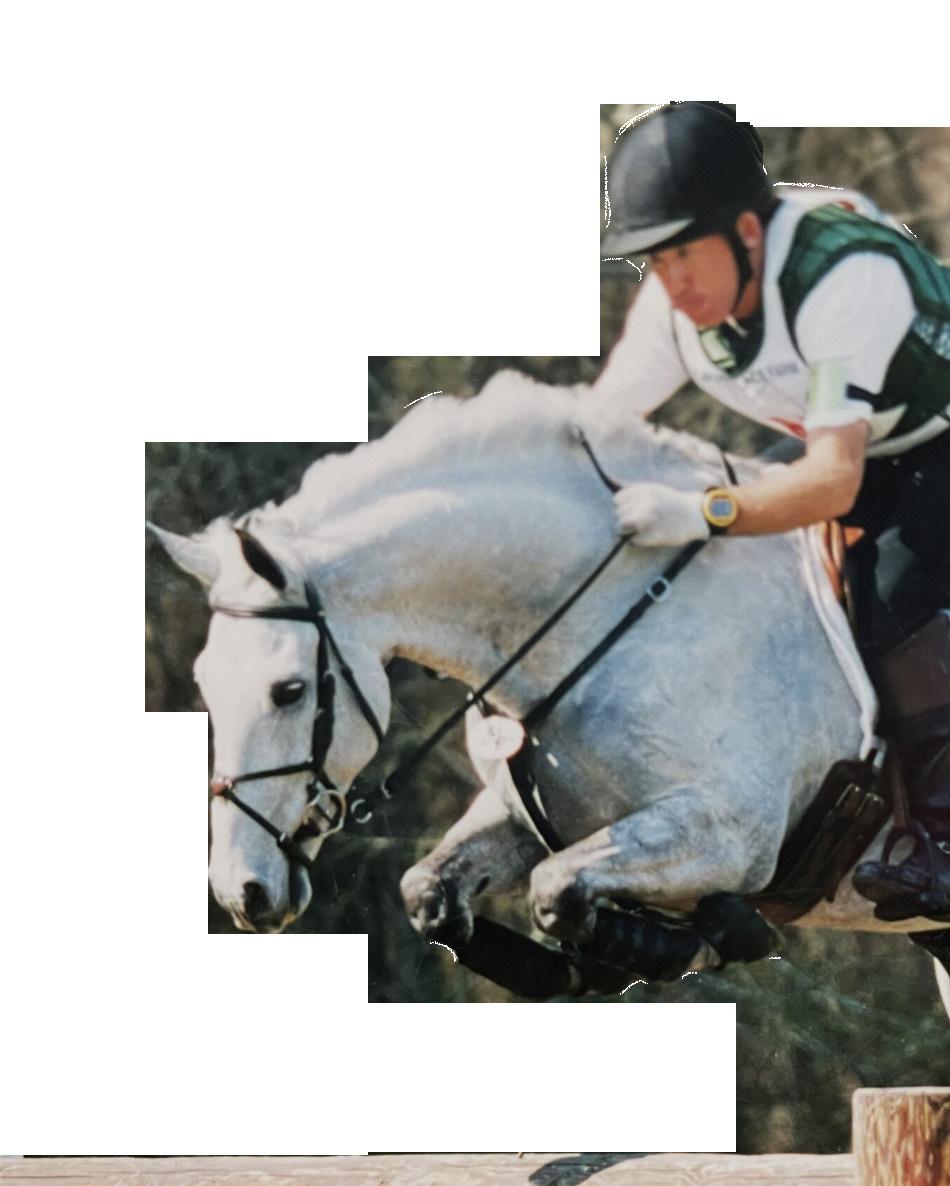









From fungal and bacterial skin issues, to sunburn, wounds and insect bite hypersensitivity, EquiShield ® provides you and your horse with science-backed solutions.


